South America is a continent that boasts a huge variety of bird species, with over 3,000 species known to inhabit the region. The avian diversity present in South America is unparalleled, ranging from colorful parrots, toucans, and macaws to majestic birds of prey like the Andean condor and harpy eagle.
The vast geographical expanse of the continent, which encompasses many different ecosystems, from dense rainforests to dry deserts, has led to the evolution of unique bird species.
The continent also acts as a wintering ground and stopover point for many migratory birds. South America’s abundant birdlife is not only a sight to behold but also plays a significant role in maintaining the ecological balance of the region.
This article aims to explore the fascinating world of birds in South America, highlighting the most noteworthy species and their importance in the ecosystem.
1. Toco Toucan
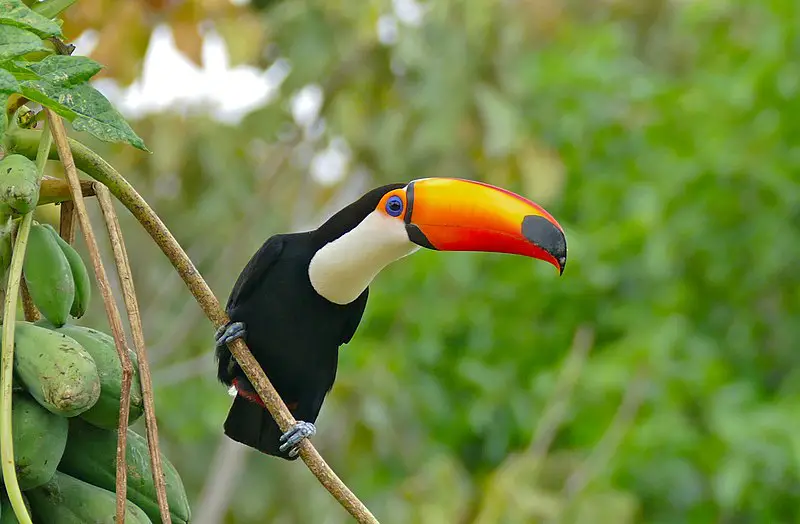
The Toco Toucan is the largest and most recognizable species of toucans, native to semi-open habitats in Central and Eastern South America.
First described by German zoologist Philipp Ludwig Statius Müller in 1776, this colorful bird has two subspecies – Ramphastos toco toco and Ramphastos toco cuvieri – distinguished by their slightly different size, plumage coloration, beak markings and range.
With its large orange bill covered with black spots along the sides of its face contrasting with yellow feathers on top of its head , it’s a very striking animal indeed.
Commonly found in zoos around the world too due tot heir loveable nature they are often kept as pets. They feed mainly on fruit but may also eat insects or small reptiles from time to time.
All in all these birds provide us a wonderful spectacle that we should appreciate for many years ahead.Scientific classification:
| Kingdom | Animalia |
| Phylum | Chordata |
| Class | Aves |
| Order | Piciformes |
| Family | Ramphastidae |
| Genus | Ramphastos |
| Species | R. toco |
Also Featured In: Beautiful Brazilian Birds, Birds That Live in the Jungle
2. Toucans
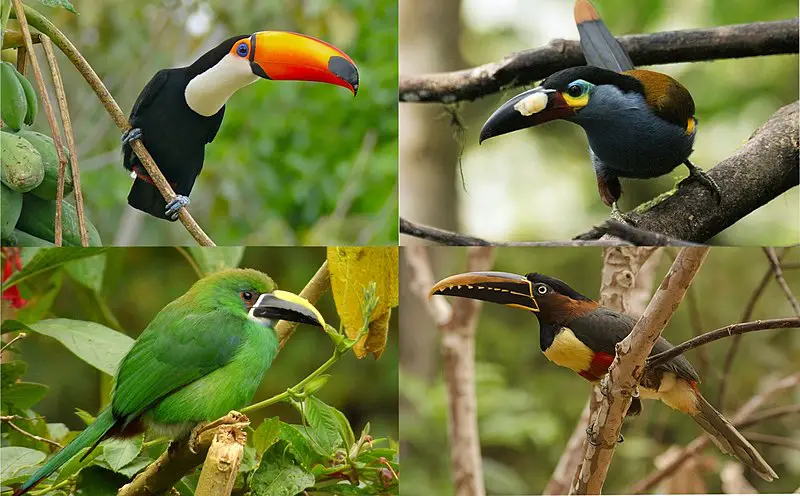
Toucans are members of the Ramphastidae family, which is closely related to American barbets. These birds have brightly-colored feathers and large beaks that come in a variety of colors.
They tend to live high up in trees, where they make their nests with two or four white eggs inside.
Toucans typically feed on fruits and sometimes small insects as well. Some species can even catch larger animals such as reptiles and amphibians for food.
Although toucans like to keep close together when living in groups, during breeding season they become more aggressive towards each other due to competition over resources like nesting sites or food sources.Scientific classification:
| Kingdom | Animalia |
| Phylum | Chordata |
| Class | Aves |
| Order | Piciformes |
| Infraorder | Ramphastides |
| Family | Ramphastidae Vigors, 1825 |
Also Featured In: Famous Paintings Birds, Rainforest Birds You Should Know
3. Hyacinth Macaw
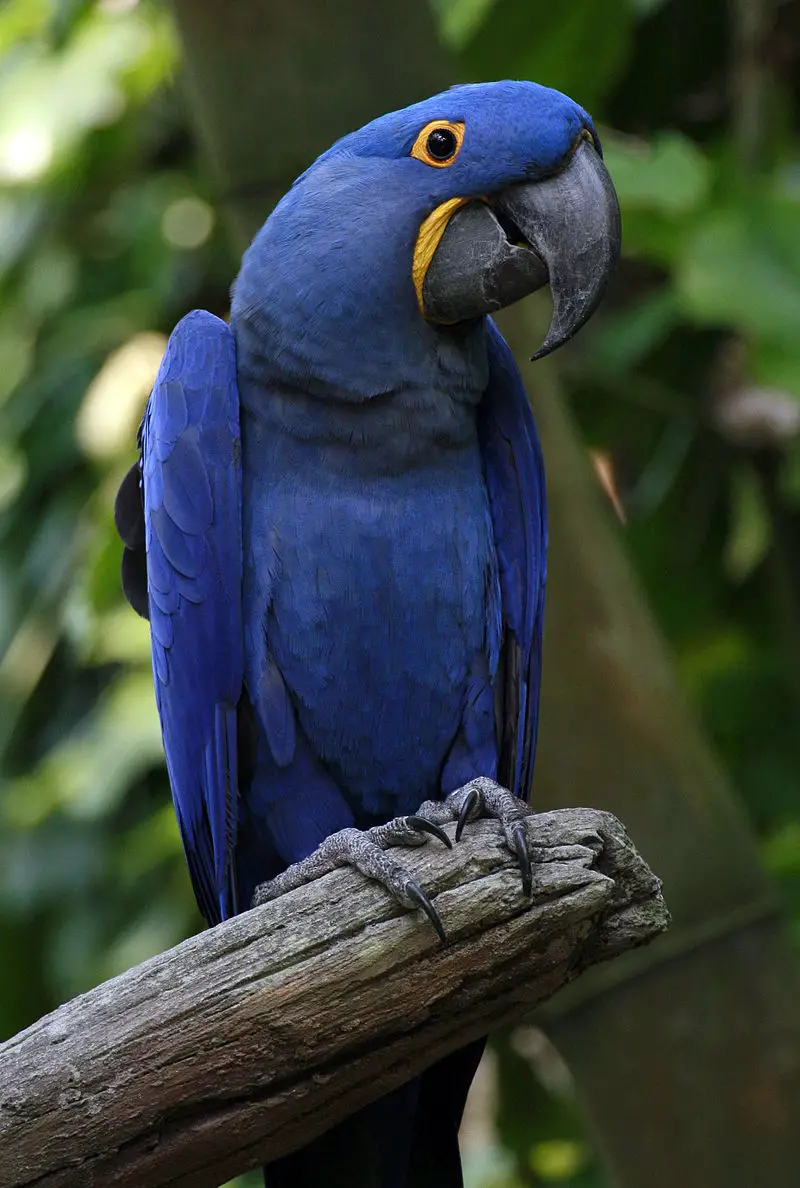
The Hyacinth Macaw is an extraordinary bird, known for its impressive size and vibrant coloration.
It has a length of around one meter, making it the longest parrot species in existence as well as the largest flying parrot species; even larger than 3.5 kg flightless Kākāpō from New Zealand.
Its striking blue plumage with yellow at its wingtips gives this majestic bird an eye-catching appearance that’s sure to turn heads wherever it goes.
Native to central and eastern South America, these birds are highly intelligent creatures who form strong bonds with their owners when kept in captivity.
They make great companions if given proper care and attention which includes providing them with plenty of space for exercise and enrichment activities such as playtime out of the cage on occasion or teaching them tricks using positive reinforcement methods like verbal praise or food rewards.Scientific classification:
| Kingdom | Animalia |
| Phylum | Chordata |
| Class | Aves |
| Order | Psittaciformes |
| Family | Psittacidae |
| Genus | Anodorhynchus |
| Species | A. hyacinthinus |
Also Featured In: Blue Birds You’ll Found around Us, Birds You’ll Find in Zoo
4. Scarlet Macaw
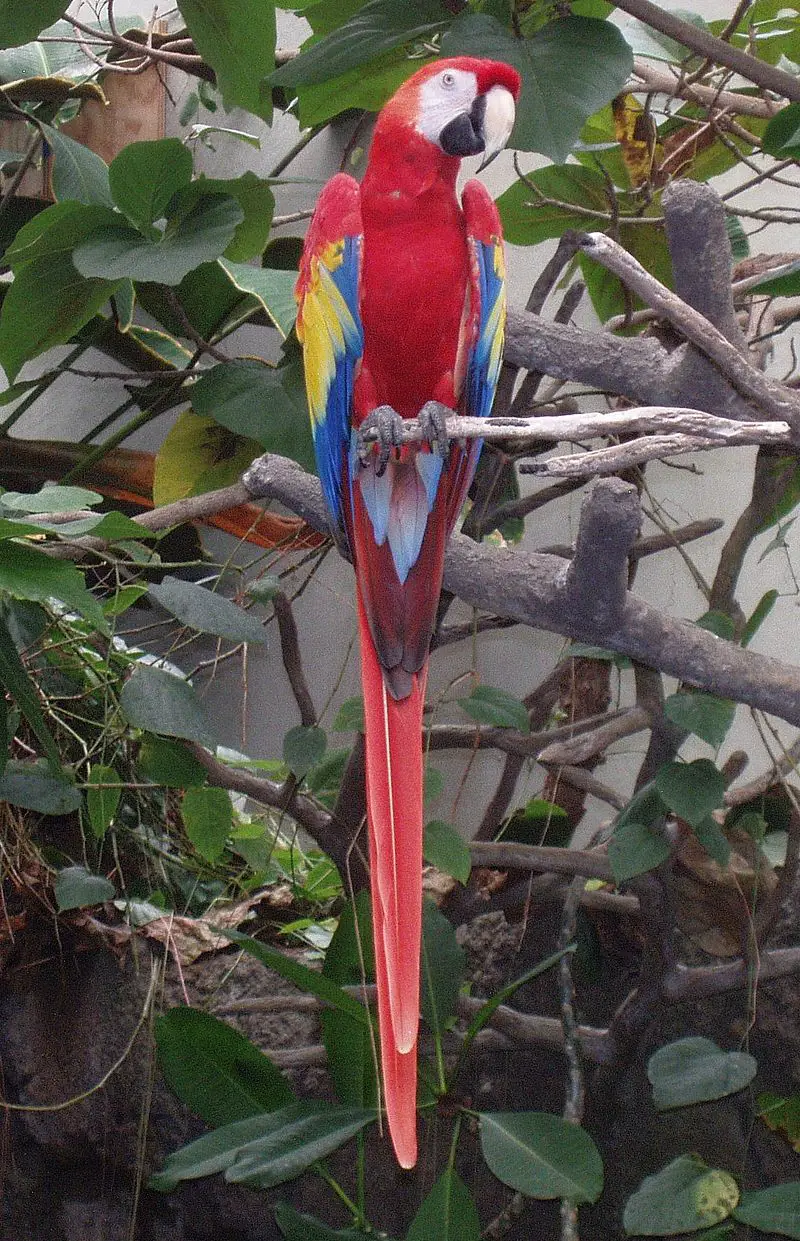
The Scarlet Macaw is a vibrant and beautiful bird found in Central and South America. Its striking red, yellow, and blue feathers make it stand out among other parrots.
It inhabits humid evergreen forests of the Neotropics from Mexico to Peru, Ecuador, Colombia, Bolivia Venezuela Brazil up to an altitude of 1000m (3300ft).
These birds have strong beaks which they use for breaking open hard nuts or seeds that would otherwise remain inaccessible.
They also form social bonds with their mates by grooming eachothers’ feathers and engaging in playful activities such as chasing one another around tree trunks.
Despite its vivid colors the Scarlet Macaw remains vulnerable due to habitat loss caused by deforestation so conservation efforts are essential if this amazing species is going to survive for future generations.Scientific classification:
| Kingdom | Animalia |
| Phylum | Chordata |
| Class | Aves |
| Order | Psittaciformes |
| Family | Psittacidae |
| Genus | Ara |
| Species | A. macao |
Also Featured In: Common Tropical Rainforest Birds, Spiritual Birds
5. Rufous-Bellied Thrush
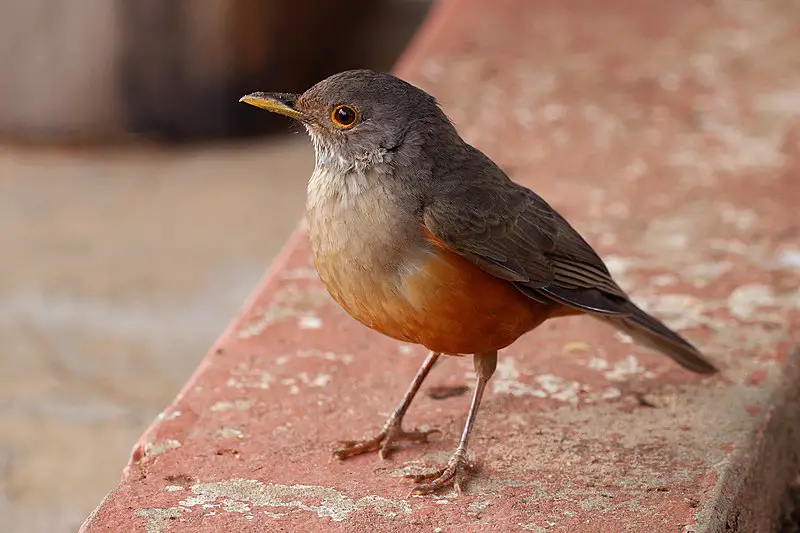
The Rufous-bellied Thrush is a songbird of the Turdidae family, commonly found in Brazil, Bolivia, Paraguay, Uruguay and parts of Argentina. It has brownish orange feathers on its back and throat while it’s underside is bright yellow.
This species likes to inhabit open woodland areas such as lowland evergreen forests or mangroves where they feed on insects like beetles, ants and caterpillars.
They are also known for their beautiful songs which consist of whistles with staccato notes at the end that make them easily identifiable amongst other thrushes.
The populations have remained relatively stable over time but due to deforestation there has been some decline in numbers so conservation efforts need to be implemented if we want this species around for many more years to come.Scientific classification:
| Kingdom | Animalia |
| Phylum | Chordata |
| Class | Aves |
| Order | Passeriformes |
| Family | Turdidae |
| Genus | Turdus |
| Species | T. rufiventris |
Also Featured In: Common Latin America Birds,
6. Greater Rhea
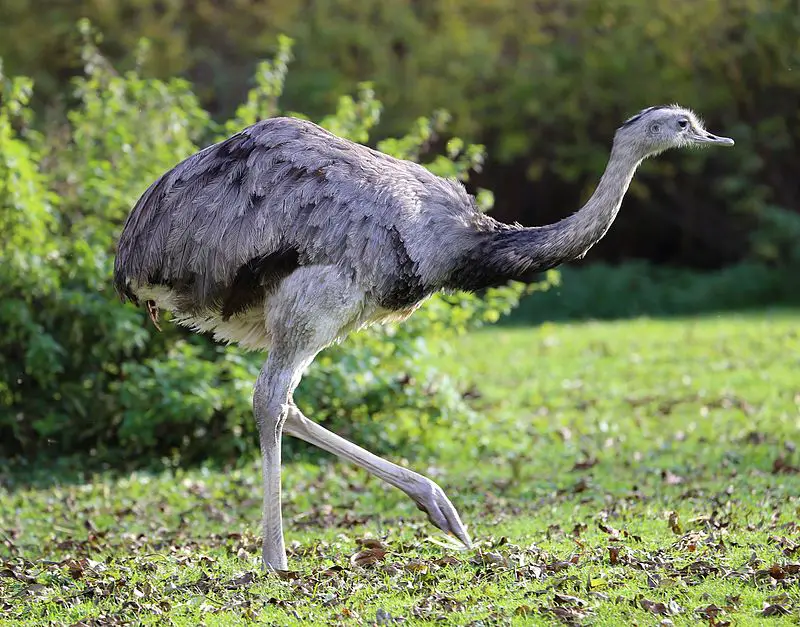
The Greater Rhea is a flightless bird native to eastern South America. It has many different names, including the Grey, Common or American Rhea, Ema (Portuguese) and Ñandú (Guaraní and Spanish).
This species of rhea lives in Brazil, Bolivia, Argentina Paraguay and Uruguay. It inhabits open areas such as grasslands with scattered shrubs and trees.
They are mostly active during the day when they feed on plants like grasses as well as small animals like insects.
The greater rheas can also be seen running away from potential predators like foxes or coyotes at high speeds up to 70 km/h.
These majestic birds have an impressive wingspan that reaches 6 feet across – making them one of the largest flying birds in their region.Scientific classification:
| Kingdom | Animalia |
| Phylum | Chordata |
| Class | Aves |
| Infraclass | Palaeognathae |
| Order | Rheiformes |
| Family | Rheidae |
| Genus | Rhea |
| Species | R. americana |
7. Wattled Jacana
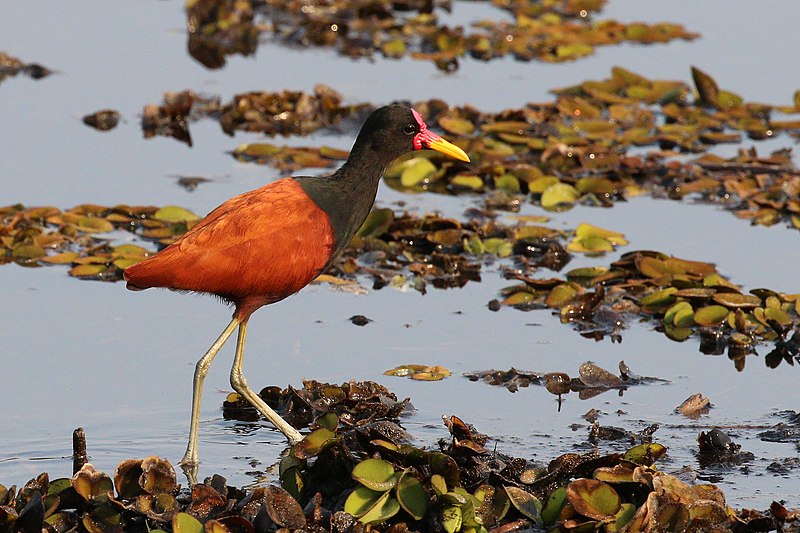
The Wattled Jacana is a stunning bird from central and south America. It has long legs, a black head with yellow wattles at each side, and striking chestnut brown wings.
This wader builds its nest on the surface of ponds or lakes using floating vegetation such as lily pads to anchor it in place – usually with four eggs that are darkly marked.
The male takes primary responsibility for incubation of these eggs between his wings, while the female will take care of her chicks once they hatch out.
These birds feed mainly on aquatic insects but also small fish and amphibians if available.
Overall this species is an interesting and attractive addition to any wetland habitat.Scientific classification:
| Kingdom | Animalia |
| Phylum | Chordata |
| Class | Aves |
| Order | Charadriiformes |
| Family | Jacanidae |
| Genus | Jacana |
| Species | J. jacana |
8. Hoatzin
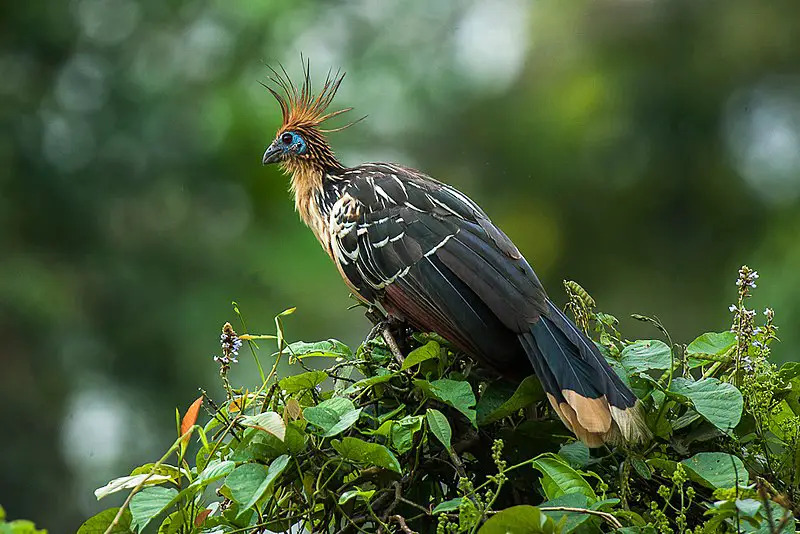
The Hoatzin bird is a tropical species found in the Amazon and Orinoco river basins of South America. It inhabits swamps, riparian forests and mangroves.
This unique bird has chicks that have claws on two of their wing digits which make it the only member in its order – Opisthocomiformes.
Its most distinctive feature is an odour produced from its digestive system which smells like cow manure.
The adults are brownish-grey with blue facial skin, red eyes, pointed crest feathers and black primaries.
They feed mainly on leaves but also eat flowers, fruits or buds when available during different seasons.
They can be heard making loud calls resembling caws at night time as well as repeated whistles throughout the day to keep contact between family members within flocks.Scientific classification:
| Kingdom | Animalia |
| Phylum | Chordata |
| Class | Aves |
| Order | Opisthocomiformes |
| Family | Opisthocomidae |
| Genus | Opisthocomus Illiger, 1811 |
| Species | O. hoazin |
9. Cracidae
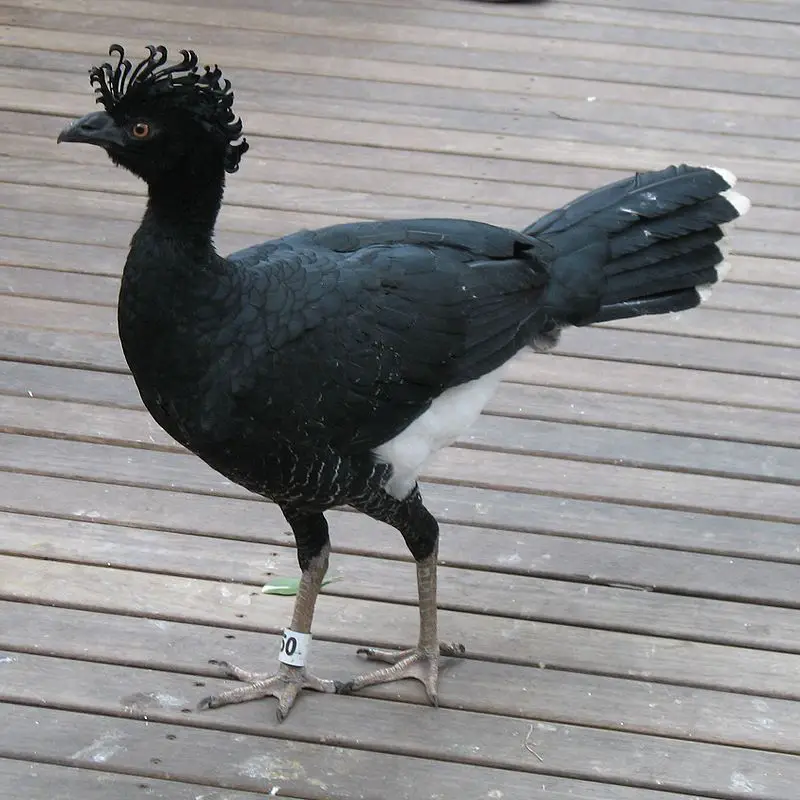
Cracidae is a family of tropical and subtropical birds found in Central and South America. The most well-known species are chachalacas, guans, and curassows.
These birds can also be seen in southern parts of Texas in the United States as well as Trinidad & Tobago islands. They typically have long tails with a rounded tip that helps them keep balance during flight or when perched on branches.
Moreover, they usually have short wings so they don’t fly very far but rather hop from tree to tree within their habitat range.
Cracids use their sharp claws for climbing trees while searching for food such as fruits, nuts insects etc.. Some members of this bird family are considered endangered due to hunting pressure by humans or loss of habitats caused by deforestation activities among others factorsScientific classification:
| Kingdom | Animalia |
| Phylum | Chordata |
| Class | Aves |
| Order | Galliformes |
| Family | Cracidae Rafinesque, 1815 |
10. Southern Lapwing
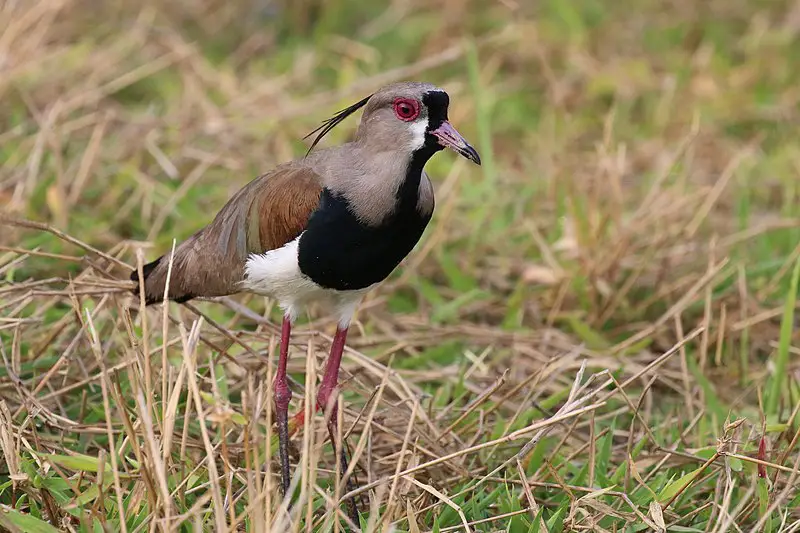
The Southern lapwing, also known as quero-quero in Brazil or tero in Argentina and Uruguay, is a wader that can be found throughout South America.
It inhabits open areas like grasslands and fields but avoids heavily forested regions such as the Amazon basin.
This bird has an unmistakable appearance with its black-and-white plumage contrasting against its bright yellow bill and legs.
The male’s feathers are more vibrant than those of the female, making them easily distinguishable from each other.
They feed on worms and insects which they search for by probing their long bills into soft ground while walking around looking for food.
Lapwings are highly territorial birds who will protect their nests fiercely from any potential predators or intruders.Scientific classification:
| Kingdom | Animalia |
| Phylum | Chordata |
| Class | Aves |
| Order | Charadriiformes |
| Family | Charadriidae |
| Genus | Vanellus |
| Species | V. chilensis |
Also Featured In: Patagonia Birds You Should Know,
11. Neotropic Cormorant
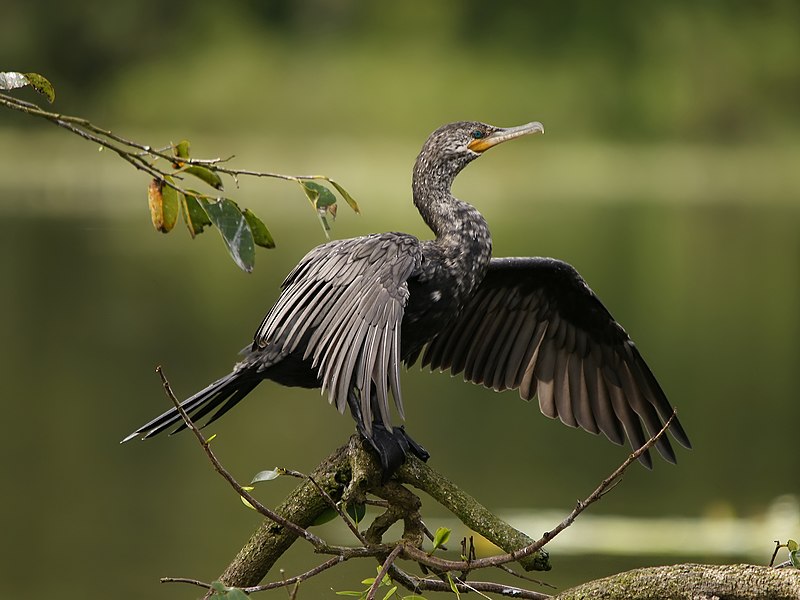
The Neotropic Cormorant, also known as the Olivaceous Cormorant, is a medium-sized bird found in tropical and subtropical regions of Central America, South America and the United States.
It can be identified by its black body with bright yellow facial skin on both sides of its large bill. The tail feathers are short and squared off at the tip.
This species breeds mainly on coasts but will sometimes nest inland near rivers or lakes during certain parts of their life cycle.
They feed mostly on small fish caught while diving underwater but can also eat crustaceans, amphibians and insects.
These birds roost in trees at night to keep safe from predators like foxes which prey upon them when they sleep close to water sources during daylight hours.Scientific classification:
| Kingdom | Animalia |
| Phylum | Chordata |
| Class | Aves |
| Order | Suliformes |
| Family | Phalacrocoracidae |
| Genus | Nannopterum |
| Species | N. brasilianum |
Also Featured In: Puerto Vallarta Birds You Should Know, Common Birds of Houston
12. Rheas
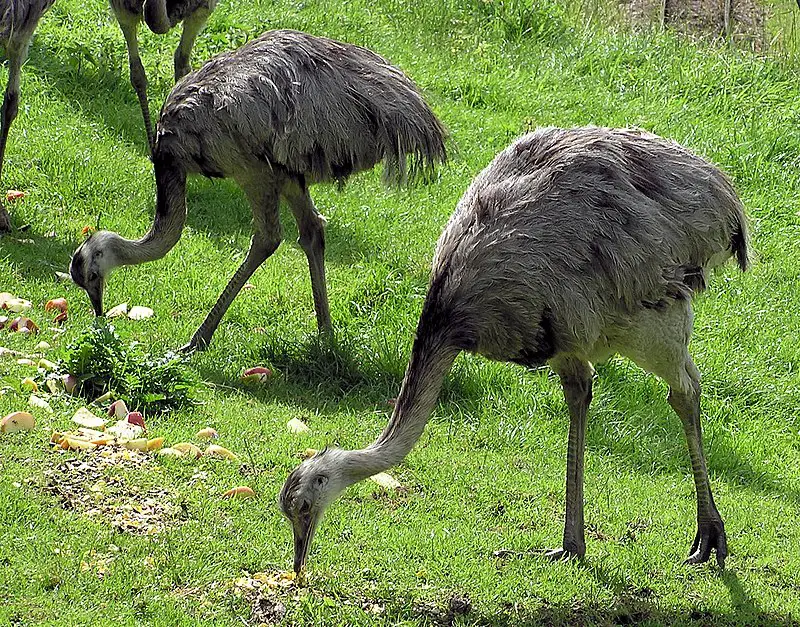
Rheas are large flightless birds native to South America, related to the ostrich and emu. There are two extant species: The Greater or American Rhea (Rhea americana) and the lesser or Darwin’s Rhea (Pterocnemia pennata).
They have long legs, strong feet with three toes that help them run swiftly on land; they can also swim well.
Their wings may be small but they’re used for balance during running. These birds usually weigh between 30-60 pounds depending on the species, with a length of up to 6 ft.
Both male and female rheas display plumage in shades of greyish browns which blend into their surroundings – perfect camouflage.Scientific classification:
| Kingdom | Animalia |
| Phylum | Chordata |
| Class | Aves |
| Infraclass | Palaeognathae |
| Order | Rheiformes |
| Family | Rheidae |
| Genus | Rhea Brisson, 1760 |
13. Magnificent Frigatebird
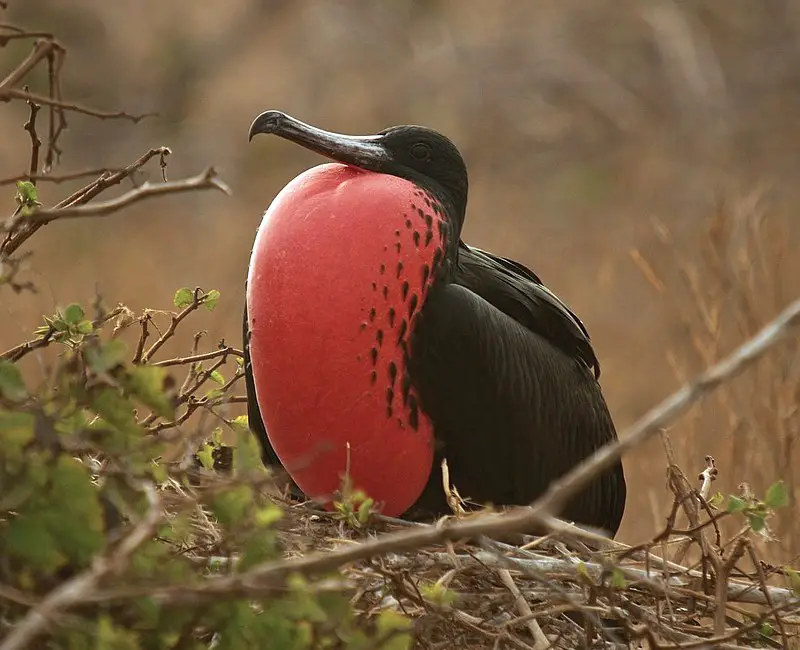
The Magnificent Frigatebird is the largest species of frigatebird, measuring between 89 and 114 cm in length and having a wingspan of 7-8 ft.
It can be found over tropical waters off America from northern Mexico to Peru on the Pacific coast, as well as Florida down south.
Its diet consists mainly of fish they take from other seabirds or snatch directly from the ocean surface while flying low above it.
They also feed on crustaceans and squid when available too.
This impressive bird has an unmistakable silhouette with its long pointed wings, forked tail feathers and male’s red gular pouch which inflates during courtship displays.Scientific classification:
| Kingdom | Animalia |
| Phylum | Chordata |
| Class | Aves |
| Order | Suliformes |
| Family | Fregatidae |
| Genus | Fregata |
| Species | F. magnificens |
Also Featured In: Top Birds Found in Mexico, Birds You’ll Find in the Sea
14. Ruddy Ground Dove
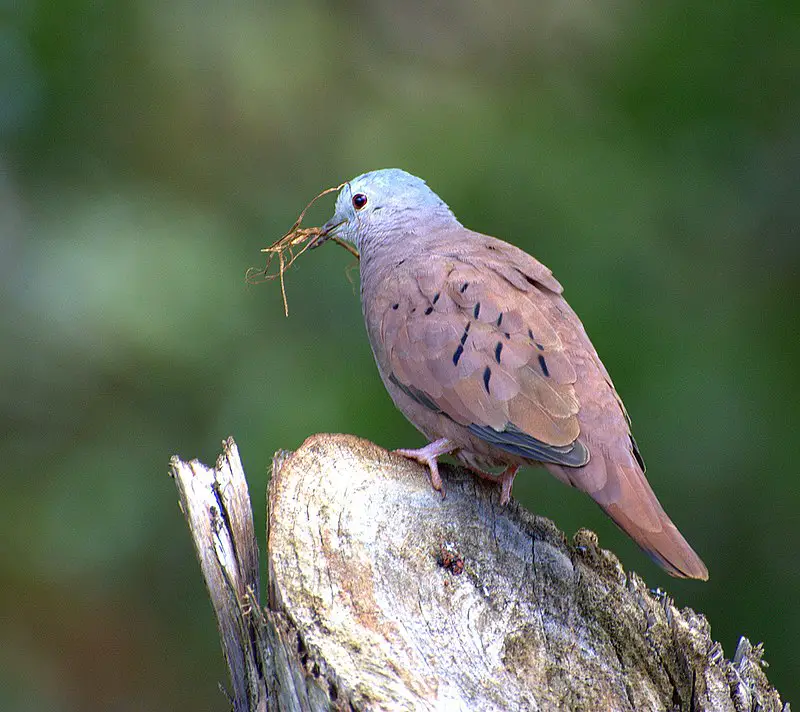
The Ruddy Ground Dove is a small New World tropical bird, found across Mexico and South America as far south as Argentina. It is also seen in the southwestern United States during winter months.
This ground dove typically lives in scrub or other open habitats such as savannas and grasslands, where it feeds on seeds from plants like cactus fruits.
Its plumage ranges from grey to reddish-brown with a light tan breast and black markings throughout its wings and tail feathers.
The male has more distinguishable colouration than the female but both sexes have bright red eyes which give this species its name – ‘ruddy’.
They are often observed perching low to the ground near food sources or nesting sites while also being quite vocal when flying between locations making them easier to spot.Scientific classification:
| Kingdom | Animalia |
| Phylum | Chordata |
| Class | Aves |
| Order | Columbiformes |
| Family | Columbidae |
| Genus | Columbina |
| Species | C. talpacoti |
Also Featured In: Common Birds of Guerrero, Most Common Birds Found in Nayarit
15. Kelp Gull
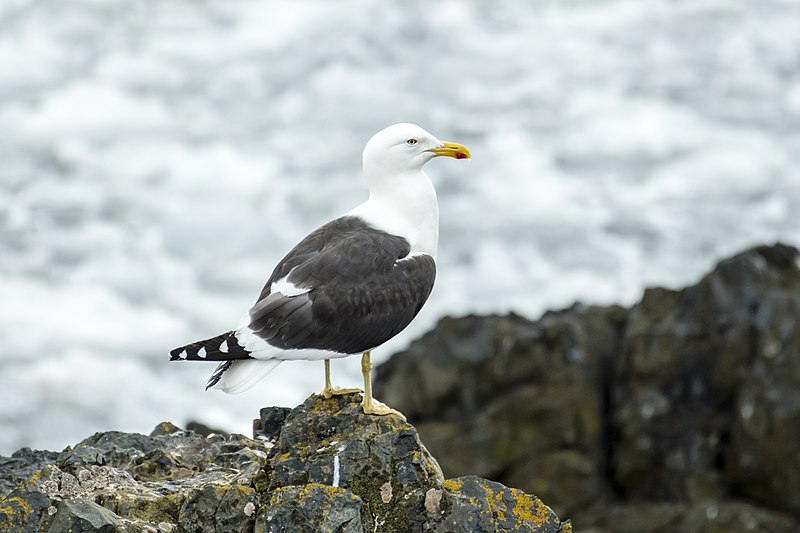
The Kelp Gull is a majestic bird that can be found on coasts and islands of the Southern Hemisphere. It has a beautiful plumage consisting of black, white and grey feathers with brown eyes.
Its wingspan ranges between 91-122 cm (36 – 48 inches). The nominate L. d. dominicanus subspecies is most commonly seen around South America, parts of Australia, and New Zealand where it goes by the name “black-backed gull” or “mollyhawk”.
These birds are omnivorous but tend to prefer fish as their primary food source while they also scavenge carrion when necessary.
In order to stand out from other seagulls during mating season they display vibrant courtship rituals which involve flying high in circles over its nesting area flapping their wings dramatically before diving down into the water near potential mates.Scientific classification:
| Kingdom | Animalia |
| Phylum | Chordata |
| Class | Aves |
| Order | Charadriiformes |
| Family | Laridae |
| Genus | Larus |
| Species | L. dominicanus |
Also Featured In: Birds of South African, Falkland Islands Birds You Need To Know
16. Andean Cock-Of-The-Rock
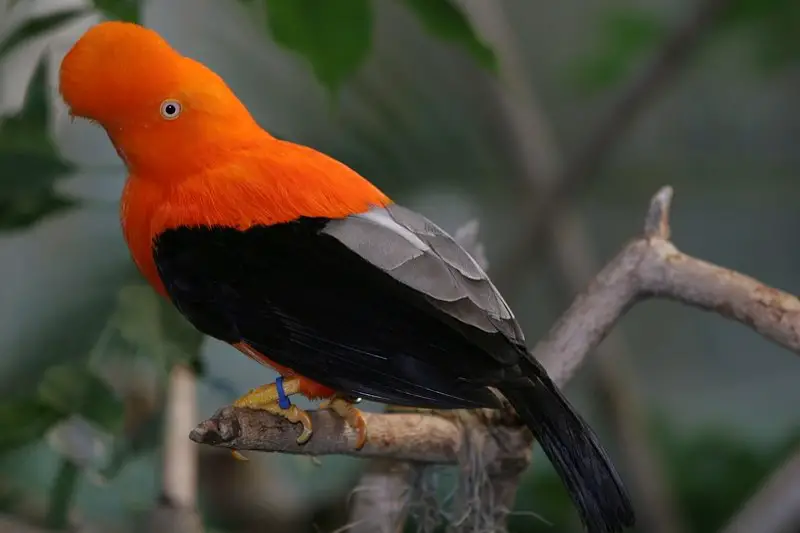
The Andean cock-of-the-rock is a large passerine bird belonging to the Cotinga family. It has four subspecies and can be found in the cloud forests of South America, notably Peru where it has been declared its national bird.
This species exhibits marked sexual dimorphism; males have an impressive orange crest that covers most of their head as well as a bright coral chest patch while females are mainly grey with dark wings and tail feathers.
Both sexes also feature black heads, yellow eyes, long bills and short legs.
Their diet consists mostly of fruits but they have also been known to eat small insects for protein.
They are monogamous birds who mate for life forming strong pair bonds that last several years until one partner dies or moves away from its territory.Scientific classification:
| Kingdom | Animalia |
| Phylum | Chordata |
| Class | Aves |
| Order | Passeriformes |
| Family | Cotingidae |
| Genus | Rupicola |
| Species | R. peruvianus |
Also Featured In: Common Birds in Colombia,
17. Andean Condor
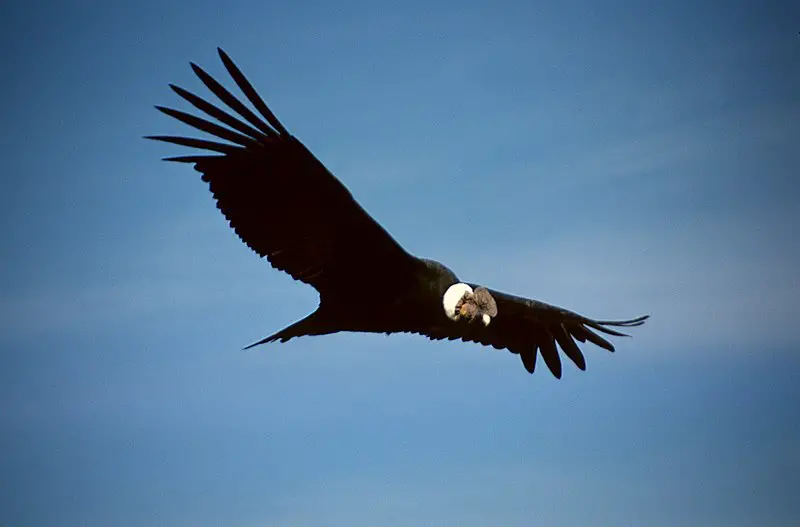
The Andean condor is a giant South American Cathartid vulture and the only member of its genus.
Found in the Andes mountains and along Pacific coasts, it is thought to be the largest flying bird on Earth by weight and wingspan with a maximum wingspan reaching up to 10 feet 10 inches (3.3 m) and weighing 33 lbs (15 kg).
It has mainly black plumage which helps keep it warm at high altitudes, while white patches adorn its head, neck, chest as well as underwing coverts.
Its powerful bill allows it to consume carrion efficiently while also being able to crack bones for nutrition when necessary.
The amazing flight capabilities of this majestic creature allow them soar through air thermals effortlessly; making them an impressive sight against clear blue skies.Scientific classification:
| Kingdom | Animalia |
| Phylum | Chordata |
| Class | Aves |
| Order | Accipitriformes |
| Family | Cathartidae |
| Genus | Vultur Linnaeus, 1758 |
| Species | V. gryphus |
Also Featured In: Aviary Birds You Should Know, Flight Birds You Should Know
18. Keel-Billed Toucan
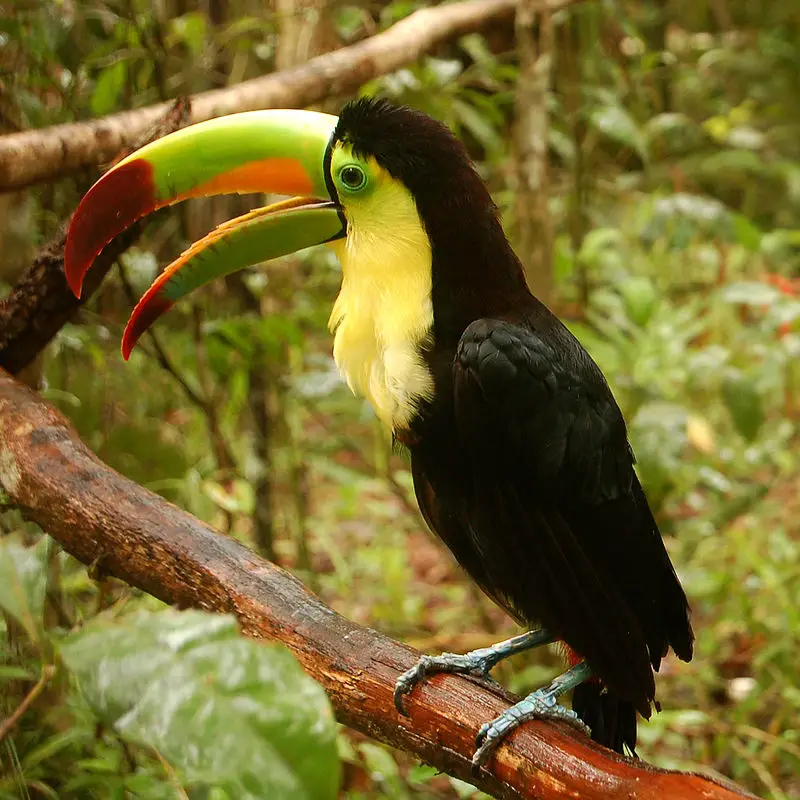
The Keel-billed Toucan is a vibrant Latin American bird from the toucan family and also serves as Belize’s national bird. They are found in tropical jungles stretching all the way from southern Mexico to Colombia.
They feed on fruits, seeds, insects, lizards and snakes – being omnivorous birds they eat pretty much anything.
These colourful creatures have an impressive beak with green upper parts of their bodies coupled with yellow lower halves.
The underside of their tail feathers are black while its tips remain white creating for quite a stunning display when flying or perched atop tree branches.Scientific classification:
| Kingdom | Animalia |
| Phylum | Chordata |
| Class | Aves |
| Order | Piciformes |
| Family | Ramphastidae |
| Genus | Ramphastos |
| Species | R. sulfuratus |
19. Tropical Mockingbird
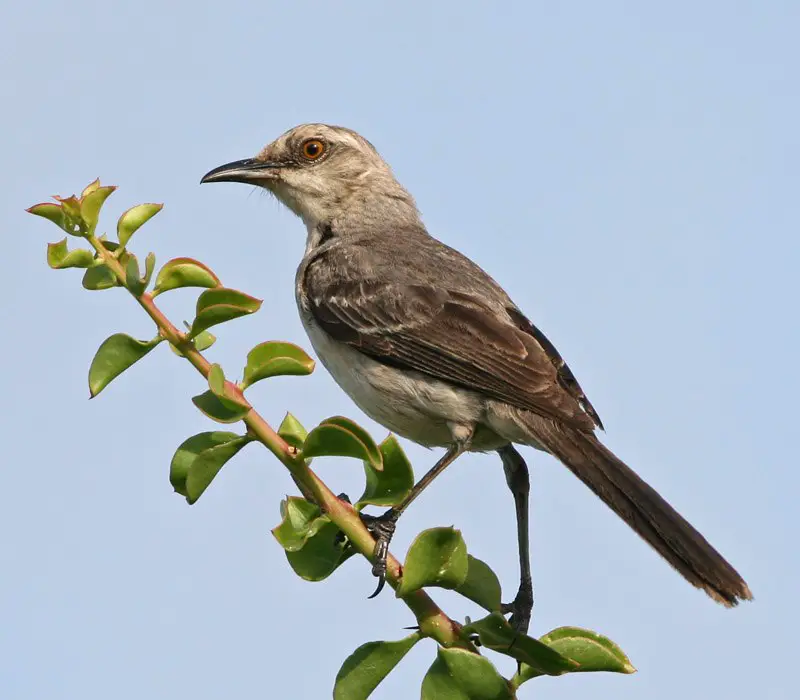
The Tropical mockingbird is a species of bird found throughout Central America and the Caribbean. It has been classified as a resident breeding bird, with its range stretching from southern Mexico to northern and eastern South America.
This species is closely related to the Northern Mockingbird, forming what is known as a superspecies between them both.
The Tropical mockingbird can be recognized by its grey-brown coloration on top, blending into white underparts which are highlighted by black spots along their throat and wings.
They have long legs for perching in trees or shrubs while searching for prey such as insects before singing out melodic songs during territorial disputes with other birds in the area.
Sadly, one subspecies -the San Cristobal Mockingbird – has been listed as critically endangered due to habitat destruction caused by human activities including logging within their natural environment.Scientific classification:
| Kingdom | Animalia |
| Phylum | Chordata |
| Class | Aves |
| Order | Passeriformes |
| Family | Mimidae |
| Genus | Mimus |
| Species | M. gilvus |
Also Featured In: Caribbean Birds, Most Common Birds You’ll Find in Quintana Roo
20. Blue-Gray Tanager
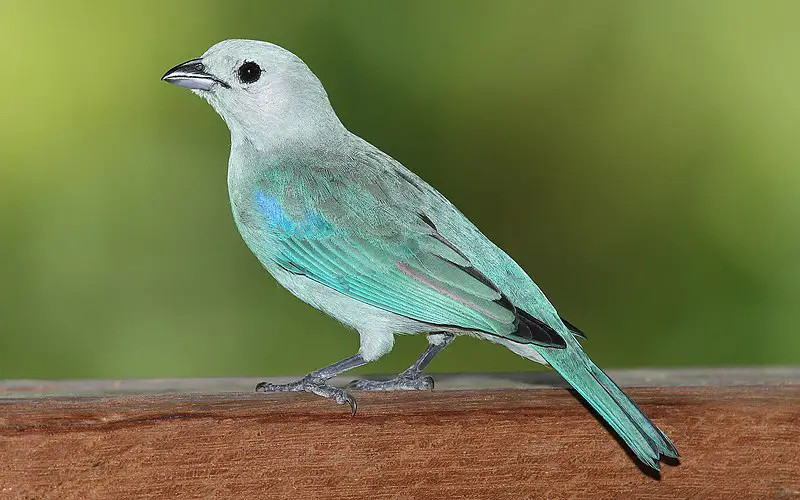
The blue-gray tanager is a medium-sized songbird native to South America, ranging from Mexico all the way down to northern Brazil and Bolivia.
It has been introduced in Lima, Peru as well as Trinidad and Tobago where it is called “blue jean”.
This species was first described by French zoologist Mathurin Jacques Brisson in 1760. The bird’s plumage features hues of gray, blue, yellow and green creating an attractive contrast against its white belly.
Its diet consists mainly of insects like beetles but also fruits such as figs are known to be part of their daily nutrition.
Blue-gray tanagers usually inhabit humid forests near running watercourses making them relatively easy to spot while they search for food on tree branches or foliage cover around streams during the day time.Scientific classification:
| Kingdom | Animalia |
| Phylum | Chordata |
| Class | Aves |
| Order | Passeriformes |
| Family | Thraupidae |
| Genus | Thraupis |
| Species | T. episcopus |
21. Smooth-Billed Ani
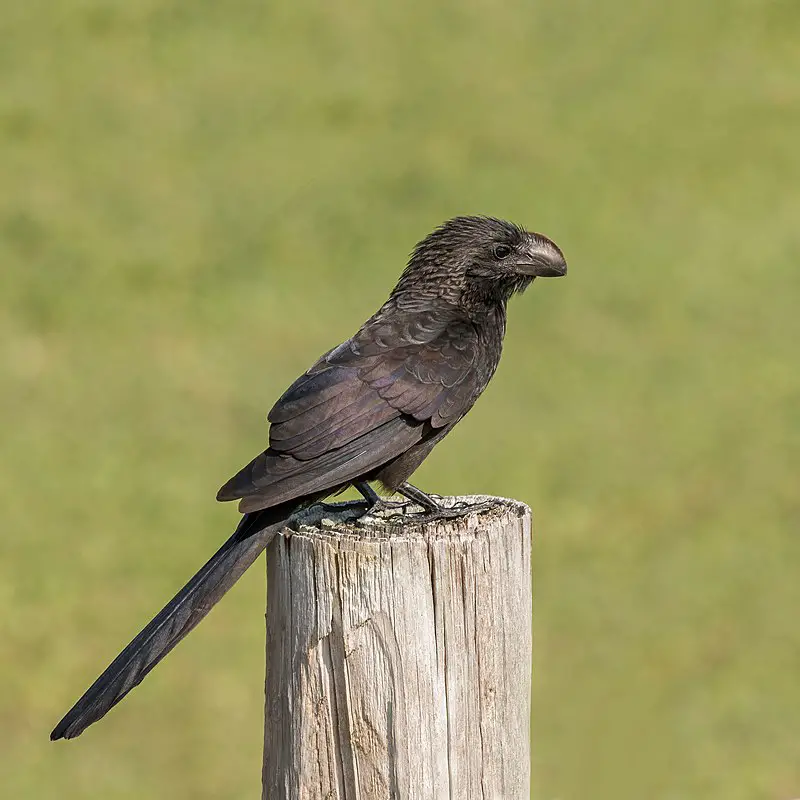
The Smooth-billed Ani is a species of bird in the cuckoo family, native to regions spanning from southern Florida and the Caribbean down through Central America, South America, and parts of Argentina.
They have even been introduced to Galapagos around 1960s where they may be impacting local wildlife due to their aggressive nature.
As its name suggests, these birds have smooth bills which are adapted for feeding on hard fruits or other items such as insects and lizards that it finds while scavenging around trees or ground level vegetation.
They usually form small flocks when out searching for food with males being slightly larger than females.
Overall this adaptable species is found in many habitats across its broad range but does best at low elevation open areas near water sources like marshes or swamps making them easier targets for human disturbance as well.Scientific classification:
| Kingdom | Animalia |
| Phylum | Chordata |
| Class | Aves |
| Order | Cuculiformes |
| Family | Cuculidae |
| Genus | Crotophaga |
| Species | C. ani |
Also Featured In: Birds that You’ll Find in Puerto Rico, British Virgin Islands Birds You Need to See
22. Eared Dove
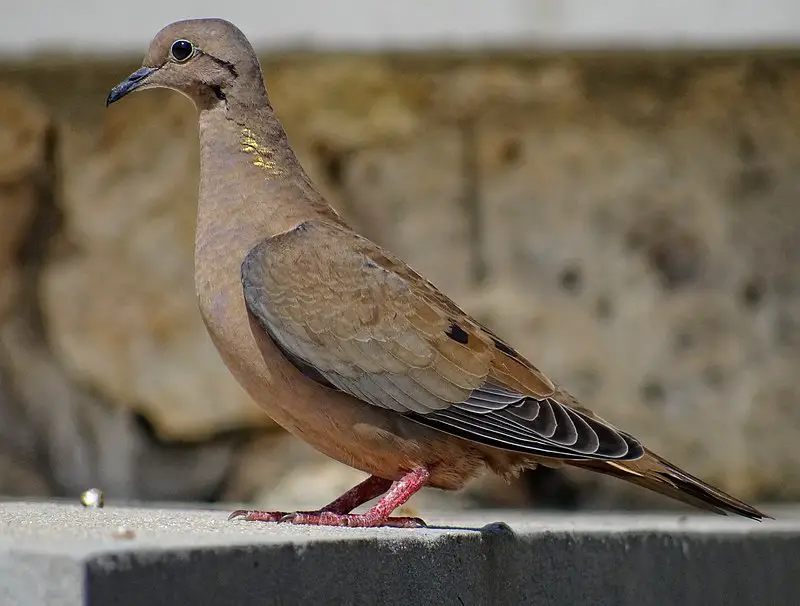
The Eared Dove is a beautiful bird that can be found throughout South America, ranging from Colombia to Argentina and Chile. It has also been spotted in Trinidad and Tobago recently.
This species tends to be partially migratory depending on food supplies available in the area, making it an important part of the local environment.
Its plumage tends to vary by region with some individuals having brighter colors than others where they are found near forested areas or along coasts.
The most recognizable feature of this dove is its ear tufts which gives it its common name – Eared Dove.
These doves have a soft cooing sound as their call which makes them truly unique among other birds in their range.Scientific classification:
| Kingdom | Animalia |
| Phylum | Chordata |
| Class | Aves |
| Order | Columbiformes |
| Family | Columbidae |
| Genus | Zenaida |
| Species | Z. auriculata |
Also Featured In: Birds Live In San José Island,
23. Harpy Eagle
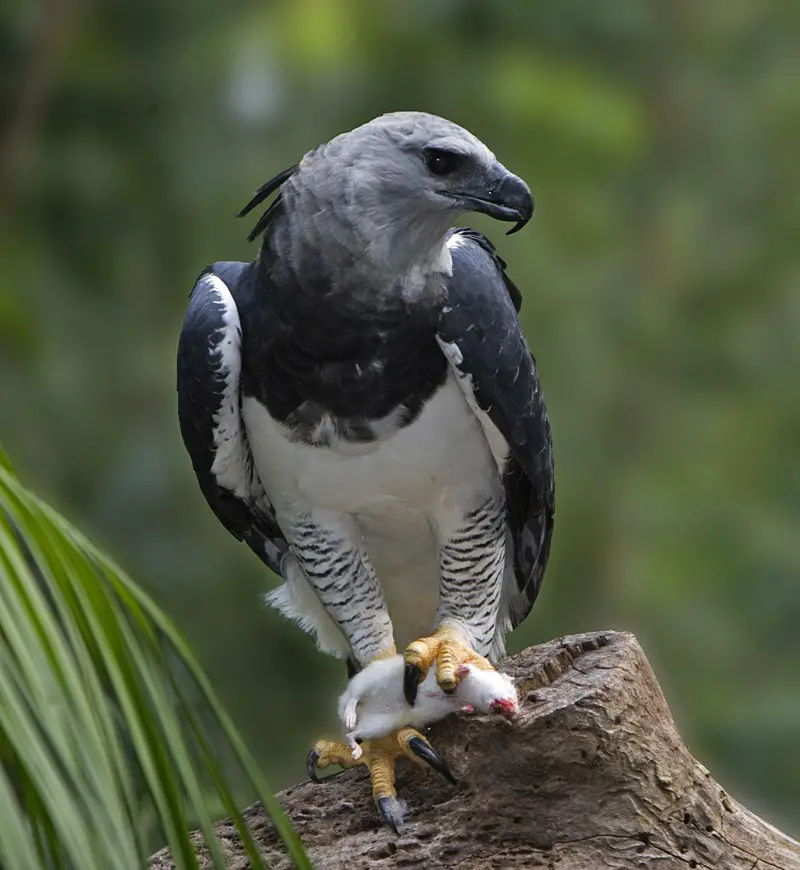
The Harpy Eagle is a magnificent bird of prey found in the tropical forests of Central and South America. It is the largest eagle on Earth, possessing an impressive wingspan that can reach up to 7 feet across.
Its powerful talons are its most distinguishing feature, being able to grasp even large animals such as monkeys or sloths with ease.
The majestic raptor has slate-gray feathers on its back and head which contrast against white undersides and yellow legs.
These birds live alone for much of their life but will come together during breeding season when they construct elaborate nests high off the ground in tall trees.
People have long been fascinated by this species’ impressive size and strength—it truly deserves its nickname as “the lord of skies”.Scientific classification:
| Kingdom | Animalia |
| Phylum | Chordata |
| Class | Aves |
| Order | Accipitriformes |
| Family | Accipitridae |
| Subfamily | Harpiinae |
| Genus | Harpia Vieillot, 1816 |
| Species | H. harpyja |
Also Featured In: Common Carnivore Birds,
24. Tyrant Flycatchers
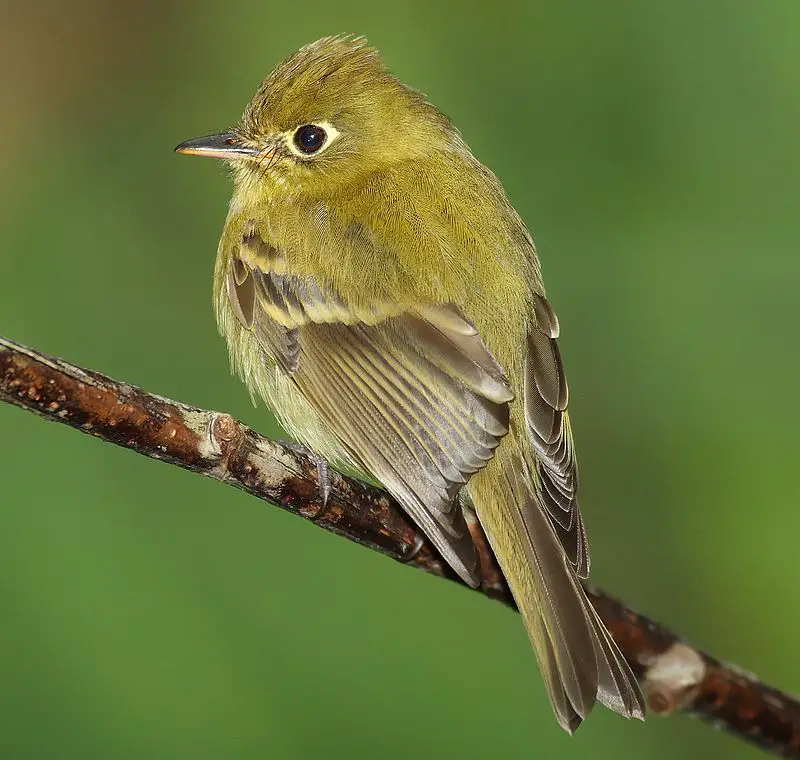
Tyrant flycatchers are a family of birds found in North and South America, containing over 400 species. These birds come in an array of shapes and sizes, with vibrant plumage to match.
They�re the most diverse avian family across all countries they inhabit except for the United States and Canada.
Their diet consists mainly of insects but also includes small reptiles or amphibians where available.
The behavior varies between each bird; some prefer open areas while others like dense forests as their habitat � many even migrate regularly.
Tyrant Flycatchers have adapted well to human presence thanks to the abundance of food sources that often accompany it � such as backyards, parks etc..
All things considered these incredible creatures are truly amazing.Scientific classification:
| Kingdom | Animalia |
| Phylum | Chordata |
| Class | Aves |
| Order | Passeriformes |
| Parvorder | Tyrannida |
| Family | Tyrannidae Vigors, 1825 |
Also Featured In: Birds of Argentina, Most Common Lake Birds
25. Rufous Hornero
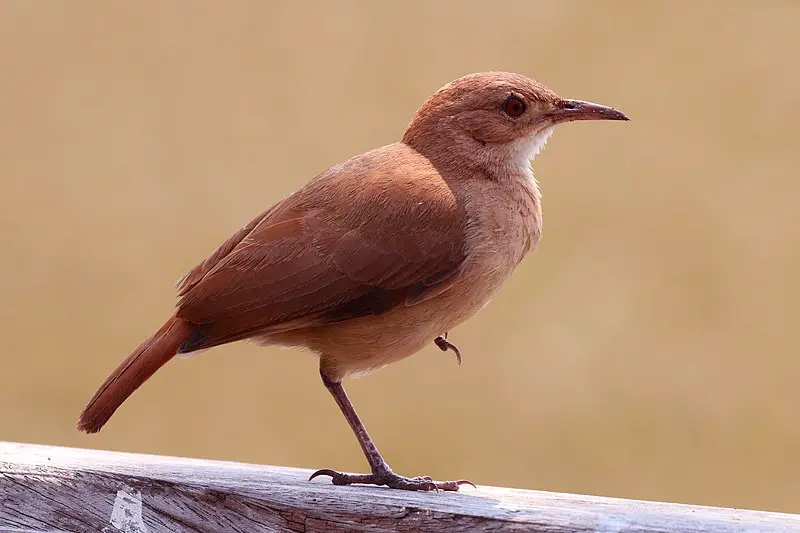
The Rufous Hornero is a small ovenbird found in eastern South America and is the national bird of Argentina. It has adapted to human environments such as pastures, agricultural land and second-growth scrub areas, making it synanthropic.
Its range stretches from midwestern Brazil to southern Bolivia, Paraguay, Uruguay and northern Argentina.
The species is easily identifiable by its rusty red plumage with dark streaks on the back of its neck along with white underparts that have black spots near their edges.
This medium-sized bird has impressive mud dome nests at top of trees or artificial structures like power poles where they lay two eggs each season which are incubated for about three weeks until hatching takes place.
They feed mainly on insects but also eat fruits when available during winter monthsScientific classification:
| Kingdom | Animalia |
| Phylum | Chordata |
| Class | Aves |
| Order | Passeriformes |
| Family | Furnariidae |
| Genus | Furnarius |
| Species | F. rufus |
Also Featured In: Birds that Make Mud Nests,
26. Ovenbird
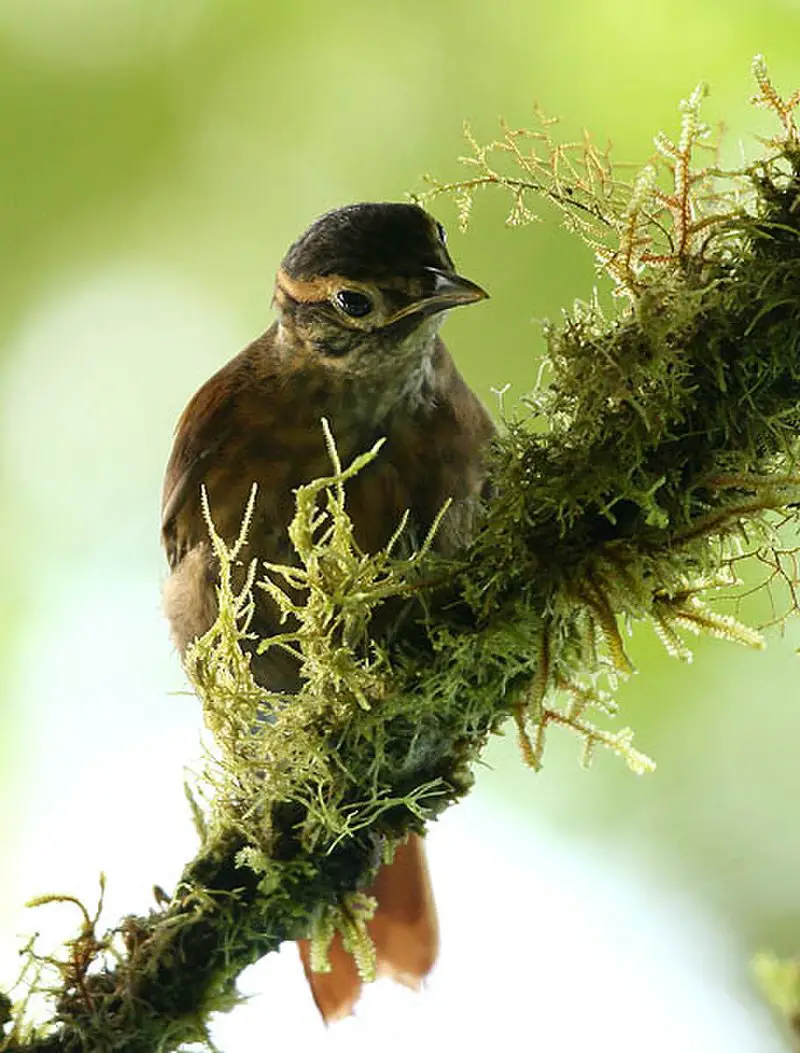
Ovenbirds are a family of small passerine birds found in Central and South America. They have around 315 species, divided into 70 genera. The most popular ovenbird is the Seiurus aurocapilla, which breeds in North America.
These birds typically inhabit wooded areas like forests or shrubland habitats, where they can forage for food such as insects and berries on the ground or low-lying vegetation.
Ovenbirds also build unique nests that resemble an oven with a side entrance—hence their name.
With its bright colours, melodic call and interesting nesting habits it’s no wonder why this bird has become so popular with birdwatchers worldwide.Scientific classification:
| Kingdom | Animalia |
| Phylum | Chordata |
| Class | Aves |
| Order | Passeriformes |
| Infraorder | Tyrannides |
| Family | Furnariidae Gray, 1840 |
Also Featured In: Birds that Migrate through Illinois in the Spring,
27. Darwin’s Rhea
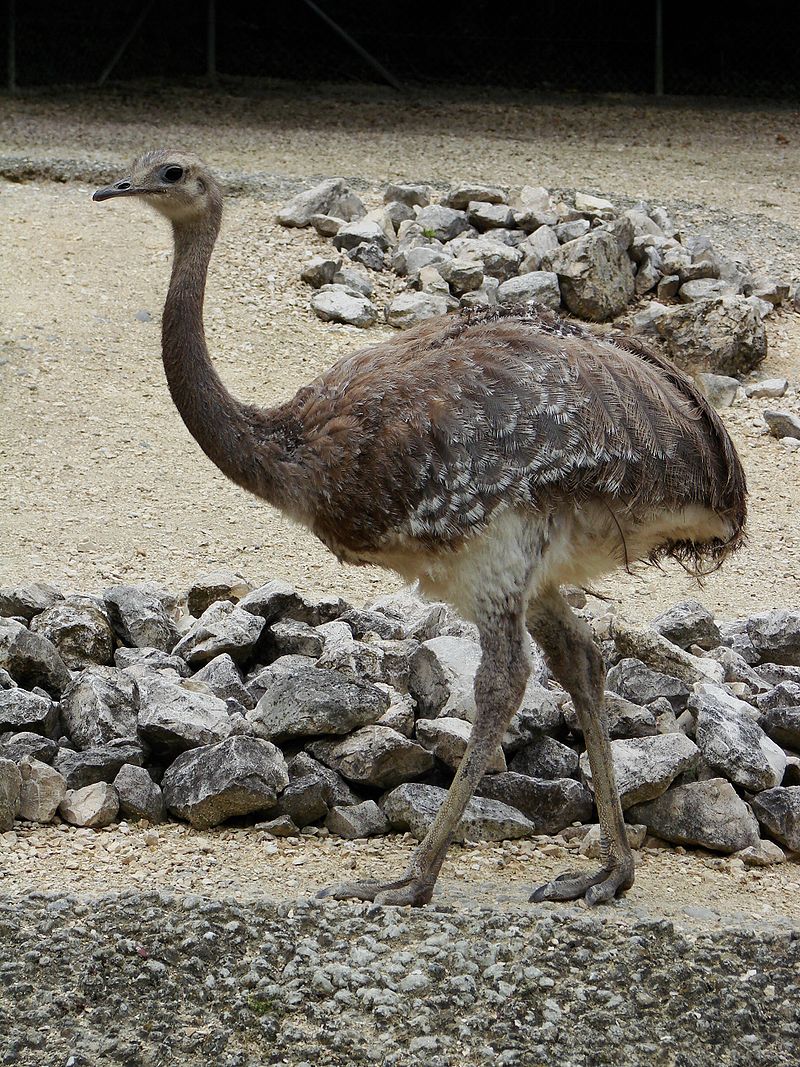
Darwin’s rhea is a flightless bird, the smaller of two extant species of rheas. It stands at 35 to 39 inches tall and has an average length of 36-39 inches with a weight range between 33 – 63 lbs.
The head and bill are both quite small in size compared to other ratites.
This large bird can be found across Altiplano and Patagonia regions in South America where it feeds on plants such as grasses, herbs, roots, bark, fruits etc., while also occasionally consuming insects and lizards.
Most notably they use their powerful legs for running away from predators like foxes or pumas who may attempt to hunt them down due to its slow speed when taking off or flying away isn’t possible.Scientific classification:
| Kingdom | Animalia |
| Phylum | Chordata |
| Class | Aves |
| Infraclass | Palaeognathae |
| Order | Rheiformes |
| Family | Rheidae |
| Genus | Rhea |
| Species | R. pennata |
28. Magellanic Penguin
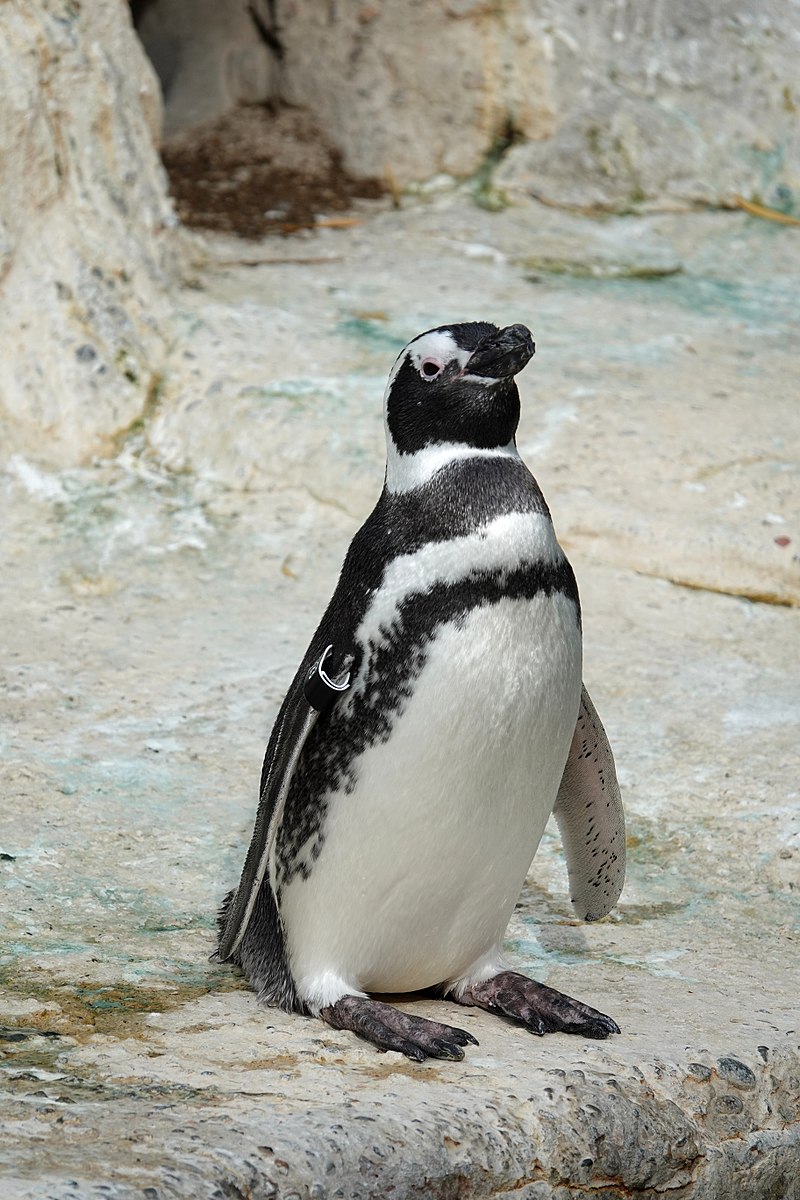
The Magellanic penguin is a beloved South American bird that breeds in coastal Patagonia, including Argentina, Chile and the Falkland Islands. It migrates to Brazil and Uruguay occasionally as far north as Espirito Santo.
Vagrants have even been spotted in El Salvador, Antarctica’s Avian Island and Australia/New Zealand.
This species of penguin is perhaps most recognizable for its striking black-and-white plumage – it has an entirely white underbelly with two distinctive stripes across its back which are black above and white below.
Additionally, they possess large pinkish feet which act like paddles when swimming underwater; these birds can swim up to 20 mph.
The Magellanic Penguin typically lives around 15 years but some may live longer due to their strong social bonds within colonies.
All in all this majestic creature makes quite the statement both on land or sea – making them a unique addition our planet’s wildlife population.Scientific classification:
| Kingdom | Animalia |
| Phylum | Chordata |
| Class | Aves |
| Order | Sphenisciformes |
| Family | Spheniscidae |
| Genus | Spheniscus |
| Species | S. magellanicus |
Also Featured In: Common Birds that Live around Ushuaia, Birds That Live around East Falkland
29. Saffron Finch
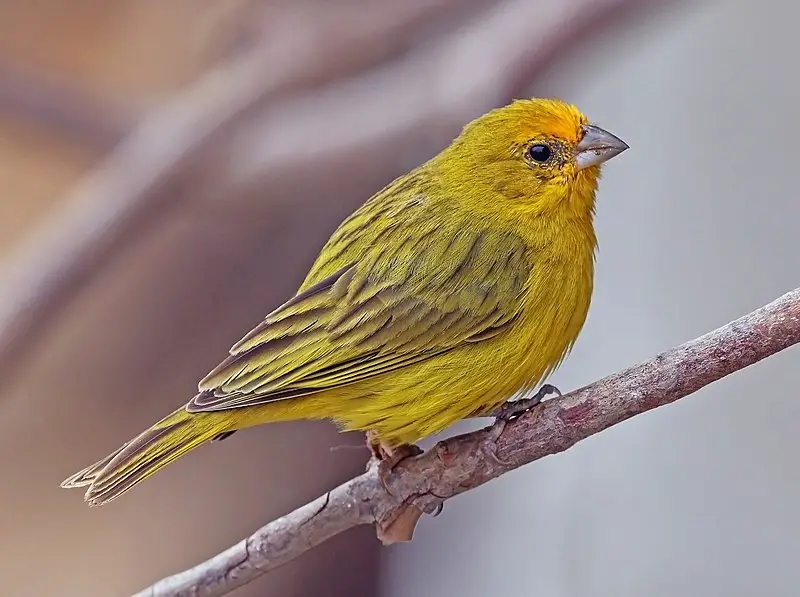
The Saffron Finch is a small tanager bird found in South America. This delightful species has an extensive distribution, ranging from Colombia to eastern Brazil and Bolivia.
They inhabit open or semi-open habitats at low elevations outside the Amazon Basin.
With their easily recognizable bright yellow feathers and cheerful song, they are often seen perching on roofs in northern Venezuela where they are referred to as “canario de tejado”.
In southern Brazil these birds are known as “canário-da-terra”, which translates into native canary.
Their diet consists mainly of seeds, grains and insects such as grasshoppers, caterpillars and beetles.
Although not threatened with extinction yet, deforestation may soon reduce their available habitat significantly if measures aren’t taken to conserve it now.Scientific classification:
| Kingdom | Animalia |
| Phylum | Chordata |
| Class | Aves |
| Order | Passeriformes |
| Family | Thraupidae |
| Genus | Sicalis |
| Species | S. flaveola |
Also Featured In: Most Common Oahu Birds, Hawaii Big Island Birds You Should Know
30. Inca Tern
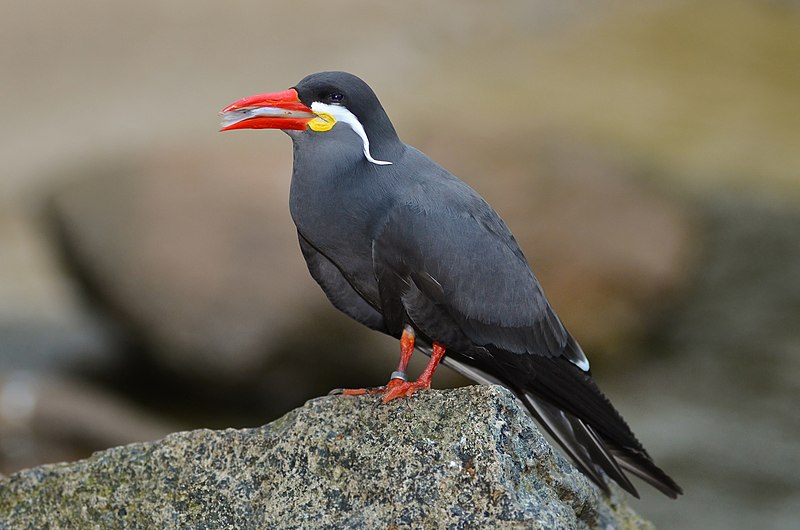
The Inca tern, found exclusively in the Humboldt Current on Peru and Chile’s coasts is a striking bird of uncommon beauty.
It has unique plumage that sets it apart from other birds in its family Laridae.
Recently, a single individual was seen making an unexpected appearance at Hawaii’s Big Island and Oahu shores – an occurrence that had previously been unheard of.
They are also known to make rare visits to Ecuadorian southwest coast too.
A graceful flyer with elegant wingspans, the Inca tern is truly remarkable for its unusual characteristics – one worth seeing if you ever get the chance.Scientific classification:
| Kingdom | Animalia |
| Phylum | Chordata |
| Class | Aves |
| Order | Charadriiformes |
| Family | Laridae |
| Genus | Larosterna Blyth, 1852 |
| Species | L. inca |
Also Featured In: Most Unique Birds in Peru,
31. Waved Albatross
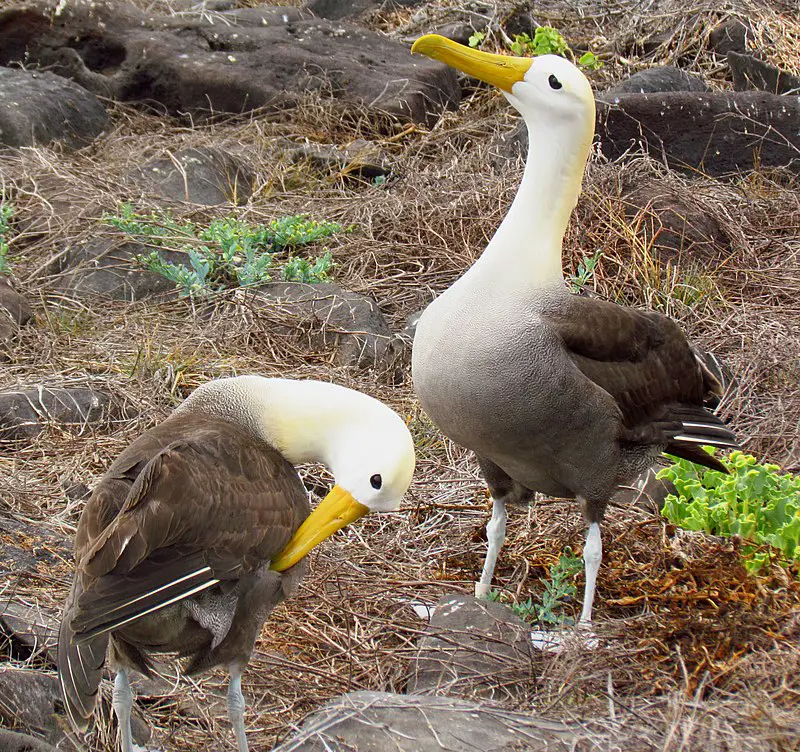
The Waved Albatross is a stunning bird with distinctive black and white plumage. It is the only species of its family Diomedeidae that inhabits in tropical regions.
During breeding season, they can be found mostly near Ecuadorian and Peruvian coasts while during non-breeding season they travel up to 1,000 km east towards Peru’s coastline foraging food.
These birds are graceful gliders soaring through the skies using their long wingspans to navigates winds effortlessly when searching for prey like fish or squid at sea surface.
They also have an impressive courtship ritual involving head nodding which was once thought extinct but thankfully has been sighted again on Galapagos islands recently.Scientific classification:
| Kingdom | Animalia |
| Phylum | Chordata |
| Class | Aves |
| Order | Procellariiformes |
| Family | Diomedeidae |
| Genus | Phoebastria |
| Species | P. irrorata |
Also Featured In: Galapagos Birds You Should Know, Birds of Galápagos Islands You Need to Know
32. Red-Legged Cormorant
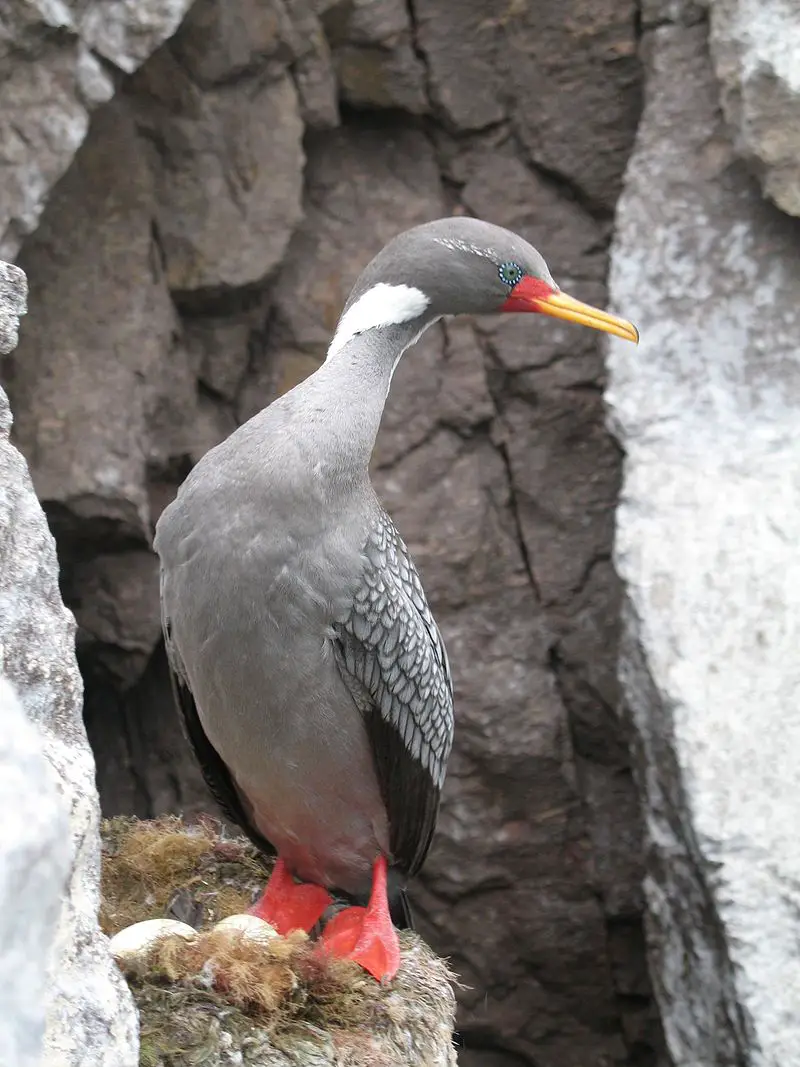
The red-legged cormorant is a species of seabird found along the coastlines of South America. It has an unusual appearance, as its feathers are mostly grey in color and it stands out with long red legs and feet.
Unlike most seabirds, this species lives alone instead of forming colonies. Red-legged cormorants have not been seen engaging in the behavior known as “wing spreading” like other birds do to dry their wings after swimming or flying through water.
Instead, they often sunbathe on rocks or logs during warm weather for hours at a time until their plumage dries off naturally from the heat of the sun’s rays.Scientific classification:
| Kingdom | Animalia |
| Phylum | Chordata |
| Class | Aves |
| Order | Suliformes |
| Family | Phalacrocoracidae |
| Genus | Poikilocarbo Boetticher, 1935 |
| Species | P. gaimardi |
33. Blue-Footed Booby
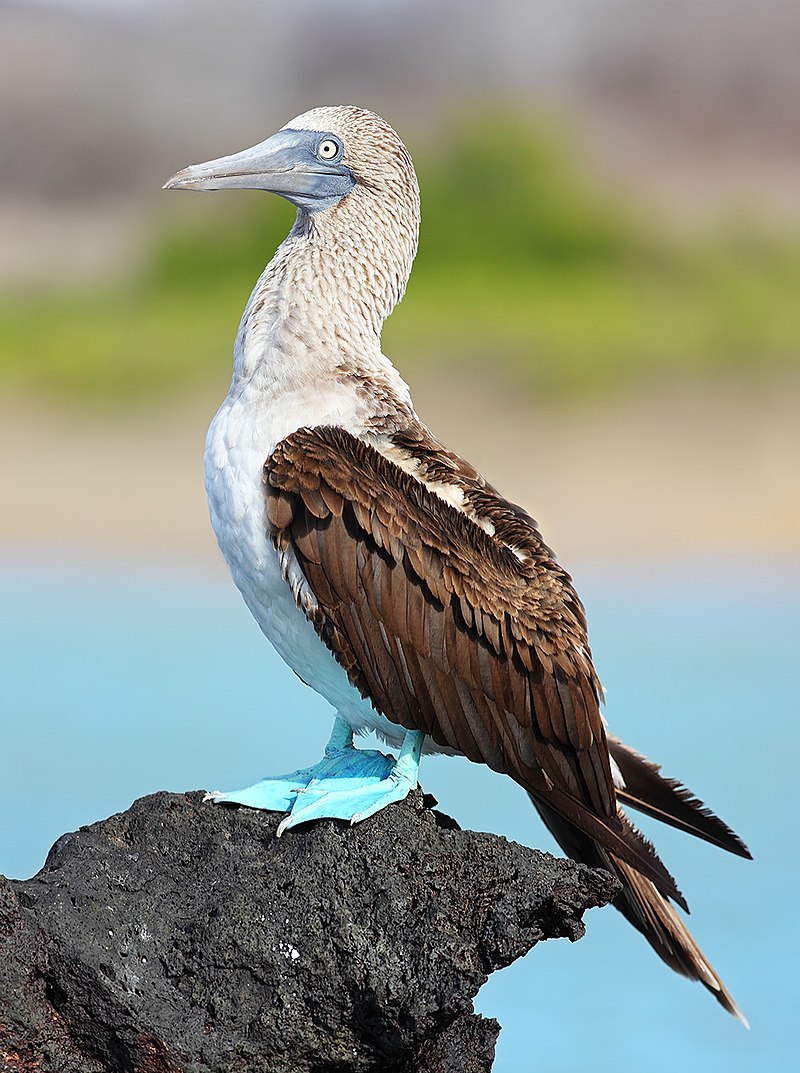
The blue-footed booby is a marine bird that can be found in subtropical and tropical parts of the eastern Pacific Ocean.
It’s one of six species from the same genus, with its unique bright blue feet being a product of their diet as well as an attractive mating ritual for males.
During this ritual, they lift up their feet to show off their brilliant colouring to potential mates.
Boobies are excellent divers, using these skills primarily to hunt fish and squid close by reefs or open ocean waters – plunging into the sea from heights between 10–30 metres.
They also feed on smaller prey such as crustaceans which float near the surface.
Their wingspan averages 1 metre across, making them graceful flyers over large distances both on land and above water surfaces alike.Scientific classification:
| Kingdom | Animalia |
| Phylum | Chordata |
| Class | Aves |
| Order | Suliformes |
| Family | Sulidae |
| Genus | Sula |
| Species | S. nebouxii |
Also Featured In: Birds of Ecuador, Birds that Live in the Ocean
34. Great Thrush
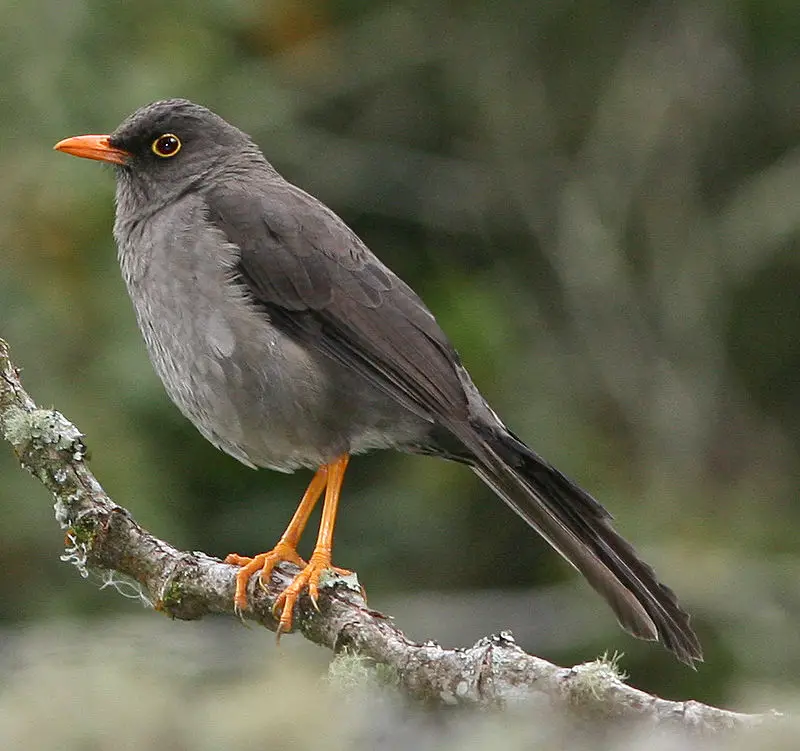
The Great Thrush is a species of bird that can be found in the mountainous regions of South American countries such as Bolivia, Colombia, Ecuador, Peru and Venezuela.
It stands out among other thrushes due to its large size and unique slate-grey coloration.
This remarkable bird resides primarily in moist subtropical or tropical montane forests at high altitudes where it feeds on fruits from shrubs and trees or searches for small insects on the ground.
The great thrush’s call has been described as having an eerie quality – somewhat musical but with some harsh notes mixed into it. Its impressive size makes this species a sight worth beholding.Scientific classification:
| Kingdom | Animalia |
| Phylum | Chordata |
| Class | Aves |
| Order | Passeriformes |
| Family | Turdidae |
| Genus | Turdus |
| Species | T. fuscater |
35. Long-Wattled Umbrellabird
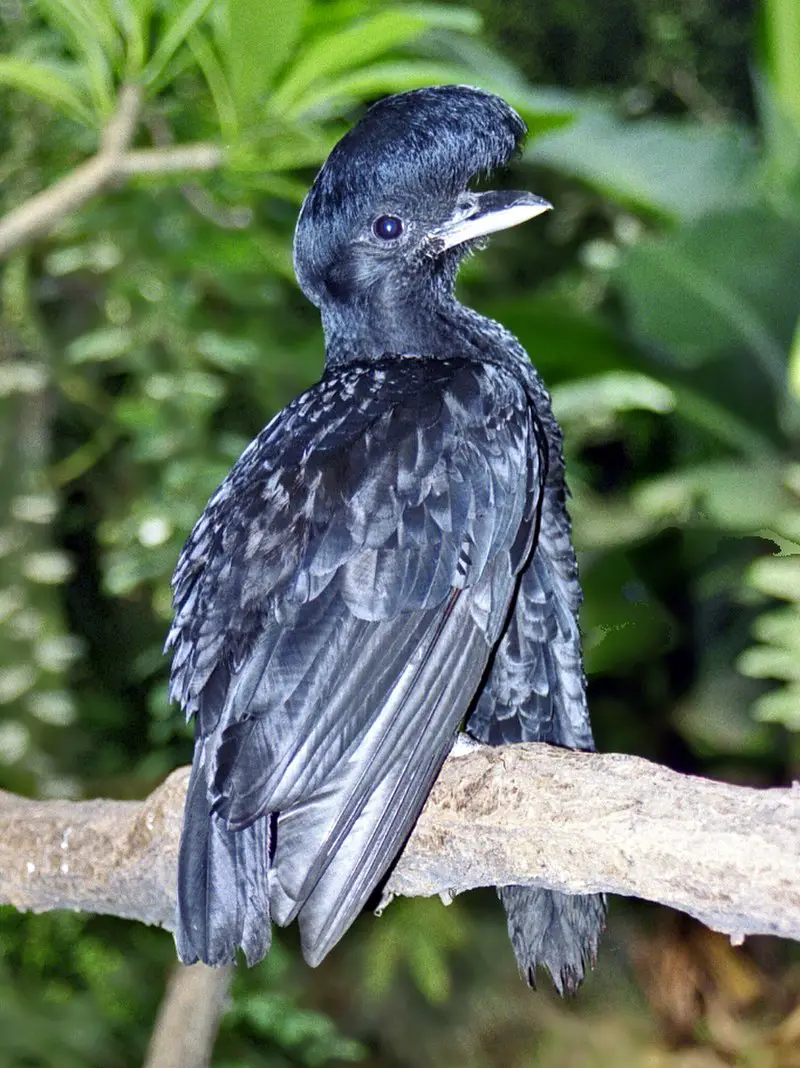
The Long-wattled Umbrellabird is a rare species of bird in the Cotingidae family, found on the Pacific slopes of Colombia and Ecuador. It prefers wet premontane and cloud forests, hence its name.
Its Spanish names include pájaro bolsón, pájaro toro, dungali, and vaca del monte – all referencing its distinctive appearance with long wattles that hang from either side of their face.
These birds are mostly black or greyish brown in colour with a yellow crown patch giving them an almost umbrellalike look when seen from above.
They have become increasingly threatened due to deforestation leading to habitat loss but thankfully there has been some work done by local conservationists to protect these remarkable creatures for future generations.Scientific classification:
| Kingdom | Animalia |
| Phylum | Chordata |
| Class | Aves |
| Order | Passeriformes |
| Family | Cotingidae |
| Genus | Cephalopterus |
| Species | C. penduliger |
36. Bananaquit
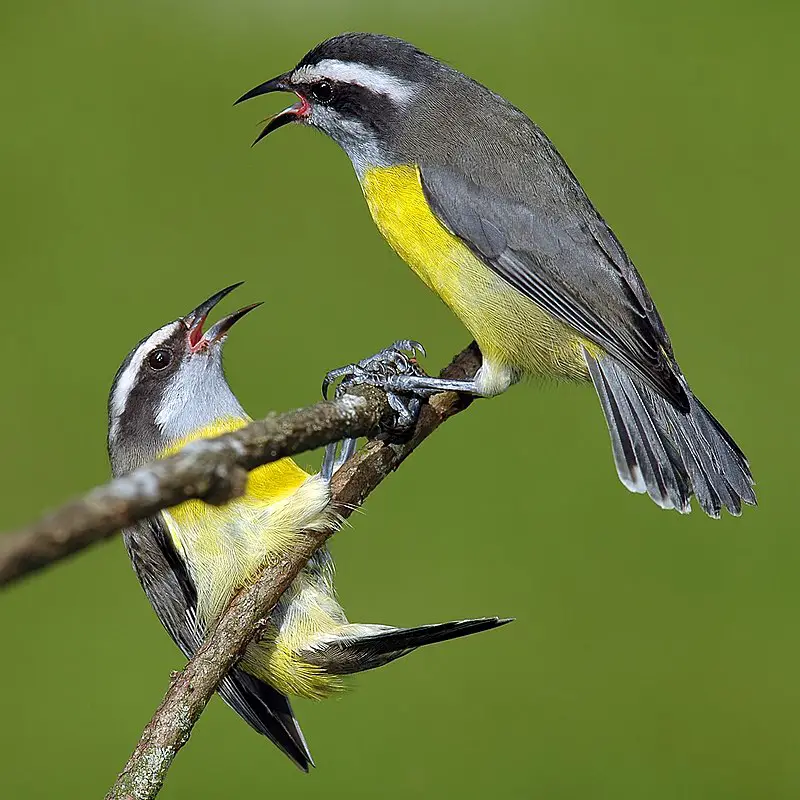
The Bananaquit, scientifically known as Coereba flaveola, is a small passerine bird belonging to the tanager family Thraupidae.
It was previously classified in either its own monotypic family or with other species such as buntings and New World sparrows (Emberizidae) or warblers (Parulidae).
This beautiful little bird has a yellow-green upper body, pale grey head and chestnut brown wings.
Its tail feathers are blackish while its belly is white with some faint streaks of olive green coloration.
The bananaquit can be found across Central America and the Caribbean islands where it feeds on fruits like bananas for which it gets its name from.Scientific classification:
| Kingdom | Animalia |
| Phylum | Chordata |
| Class | Aves |
| Order | Passeriformes |
| Family | Thraupidae |
| Genus | Coereba Vieillot, 1809 |
| Species | C. flaveola |
Also Featured In: Dominican Republic birds, Martinique Island Birds You Should Know
37. Great Curassow
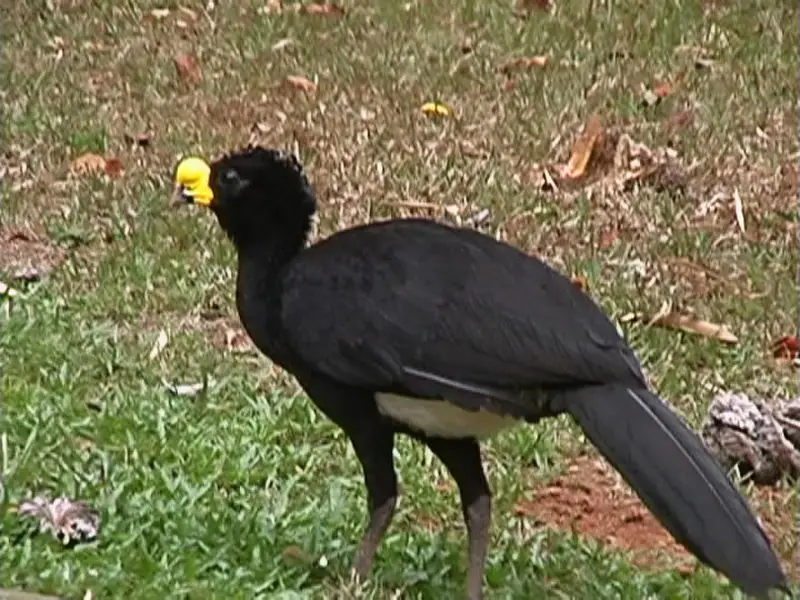
The Great Curassow is an impressive bird, found in the Neotropical rainforests. Males are easily identified by their black color and yellow beaks, while females come in three distinct morphs: barred, rufous or black.
These birds have a pheasant-like shape and can form small groups when foraging on the ground for fruits.
The range of this species extends from eastern Mexico to western Colombia and northwestern Ecuador; however they can also be seen in other regions like Costa Rica where conservation efforts are helping with population growth.
While not considered endangered yet, destruction of its natural habitat does pose threats to these majestic creatures if it’s not properly managed soon enough.Scientific classification:
| Kingdom | Animalia |
| Phylum | Chordata |
| Class | Aves |
| Order | Galliformes |
| Family | Cracidae |
| Genus | Crax |
| Species | C. rubra |
Also Featured In: Birds of Honduras, Birds that Live in Tabasco
38. Bare-Throated Bellbird
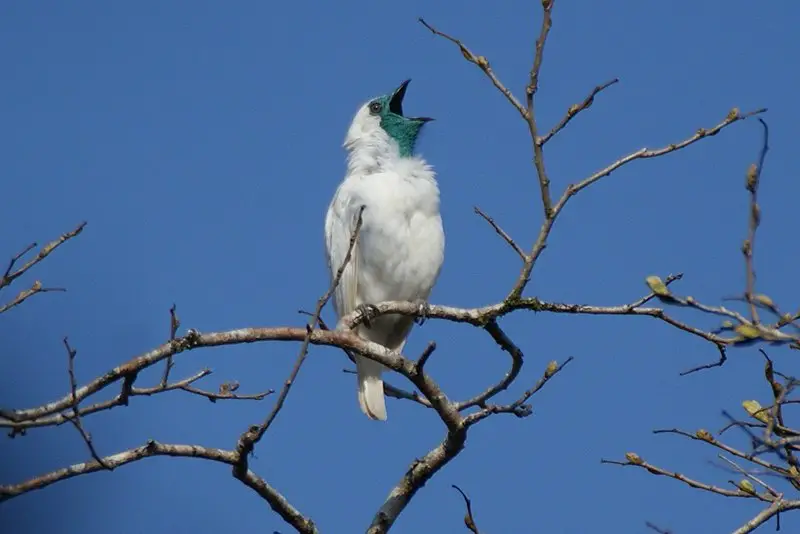
The bare-throated bellbird is a species of bird found in moist subtropical and tropical forests in Argentina, Brazil, and Paraguay. Its male counterpart has striking white plumage with bluish-black skin around its eye, beak and throat.
The female is more drab with olive-brown upperparts contrasting against streaked yellow underparts.
One of the most impressive qualities of this bird however is its astounding vocal range – it can produce one of the loudest sounds amongst birds.
It’s song consists mainly of deep tones which when combined form an incredible melodic sound that resonates through their forest habitats.
This truly remarkable creature should definitely be appreciated for both its beauty as well as its unique call.Scientific classification:
| Kingdom | Animalia |
| Phylum | Chordata |
| Class | Aves |
| Order | Passeriformes |
| Family | Cotingidae |
| Genus | Procnias |
| Species | P. nudicollis |
Also Featured In: Most Common Birds In Paraguay,
39. Great Kiskadee
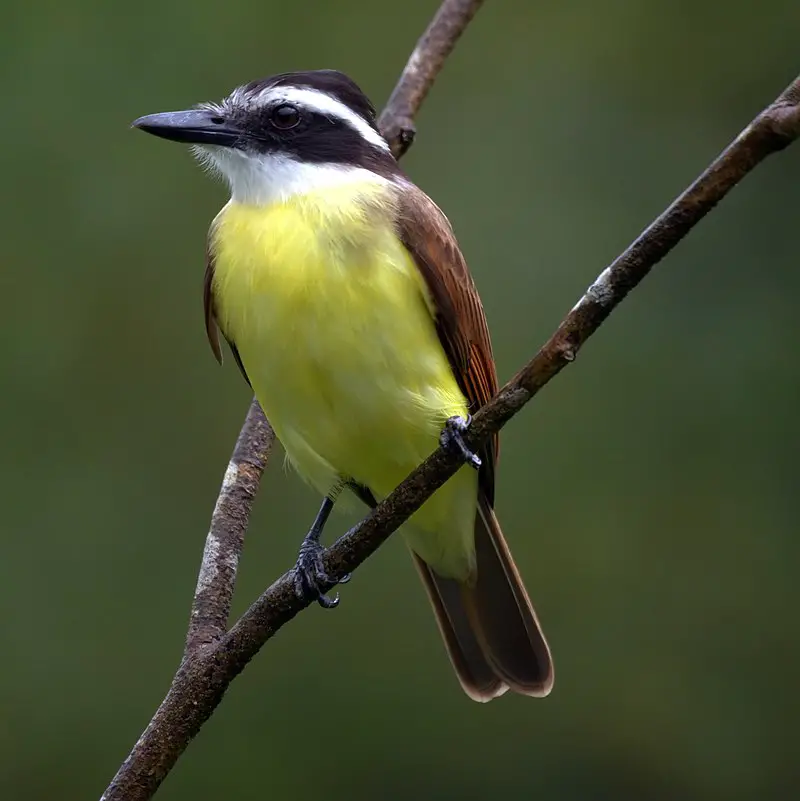
The Great Kiskadee is a passerine bird belonging to the Tyrant Flycatcher family.
It has an unmistakable yellow and black plumage, making it easily recognizable in its native habitats of Belize, Texas, Argentina and Brazil where it is known as Bem-te-vi or Benteveo respectively.
The species inhabits open woodland with some tall trees such as cultivation areas and other places surrounding human dwellings.
This adaptable bird feeds mainly on insects but also consumes fruit for energy when needed.
Its call resembles laughter which adds to its charm among avid nature watchers who are always delighted by their presence.
A unique feature that sets this species apart from others is that they can imitate songs of other birds accurately too.Scientific classification:
| Kingdom | Animalia |
| Phylum | Chordata |
| Class | Aves |
| Order | Passeriformes |
| Family | Tyrannidae |
| Genus | Pitangus Swainson, 1827 |
| Species | P. sulphuratus |
Also Featured In: Birds You’ll Find in South Texas , Birds You’ll Find in the Rio Grande Valley
40. Savanna Hawk
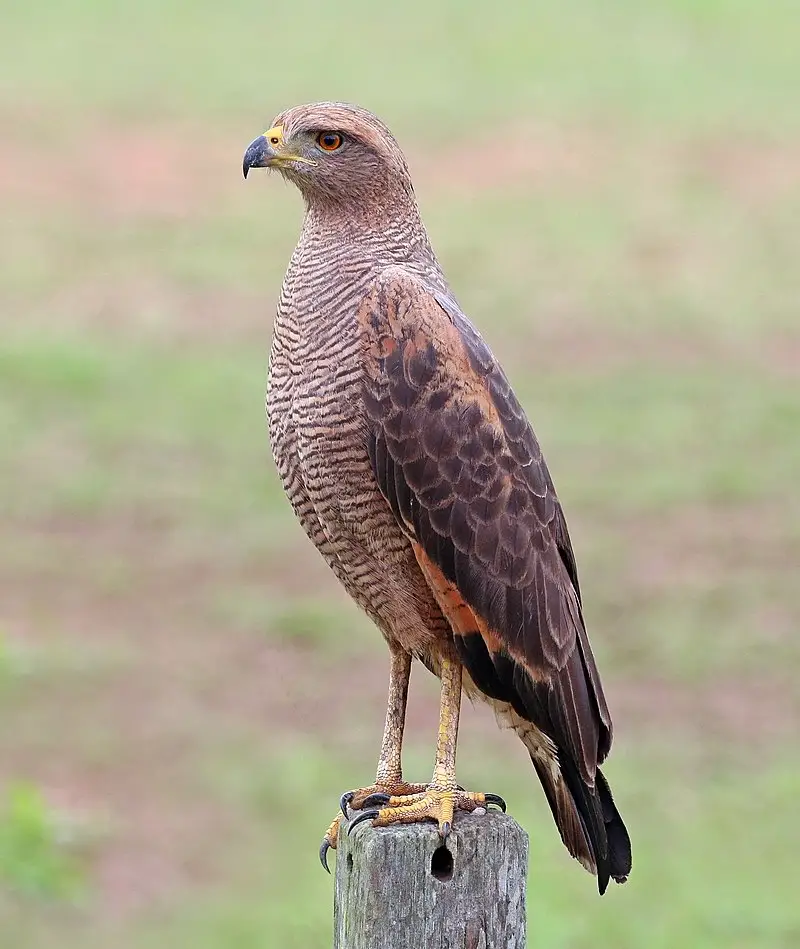
The Savanna Hawk is a large raptor found mainly in open savannas and swamp edges, ranging from Panama to Bolivia. It has an unmistakable rufous body with grey mottling above and fine black barring below.
Its length ranges between 46-61 cm (18-24 inches) with a weight of 845g (29.8oz).
These birds are fierce hunters who feed on small mammals, reptiles, amphibians or insects which they capture during flight using their powerful talons or beak.
They build nests high up in trees preferably along the edge of forests where they can spot prey easily over long distances due to their excellent vision capabilities.
The Savanna Hawk is known for its loud calls that echo through the skies as it soars across the landscape looking for its next meal.Scientific classification:
| Kingdom | Animalia |
| Phylum | Chordata |
| Class | Aves |
| Order | Accipitriformes |
| Family | Accipitridae |
| Genus | Buteogallus |
| Species | B. meridionalis |
Also Featured In: Savanna Birds You Need to See,
41. Tropical Kingbird
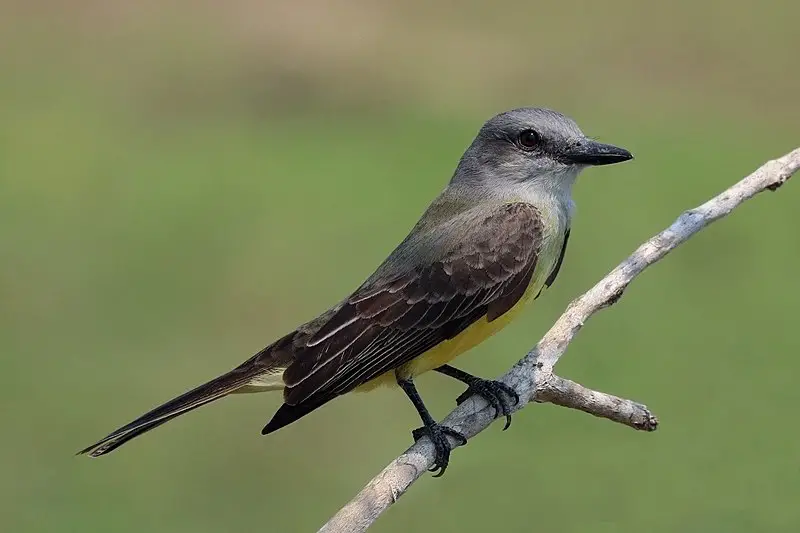
The Tropical Kingbird is an impressive bird, native to the Americas. It’s a large tyrant flycatcher that breeds in southern Arizona and Texas through Central America and down south as far as Argentina and Peru.
This species also lives on Trinidad & Tobago islands. During cold winter months, most of them migrate to warmer climates within its range.
They inhabit open areas such as fields or forests with scattered trees – but away from heavily wooded habitats.
In terms of diet, they mainly feed upon insects which are caught by hawking from perches or snatching up in flight; however it will occasionally eat fruits too.
The adult has grey-brown upperparts, darker wings edged with yellowish feathers plus a white breast band contrasting against pale orange underparts for both sexes.
A conspicuous black mask runs across their eyes completing this beautiful bird’s look.Scientific classification:
| Kingdom | Animalia |
| Phylum | Chordata |
| Class | Aves |
| Order | Passeriformes |
| Family | Tyrannidae |
| Genus | Tyrannus |
| Species | T. melancholicus |
Also Featured In: British Columbian Birds, Yellow Birds of Arizona
42. Rufous-Collared Sparrow
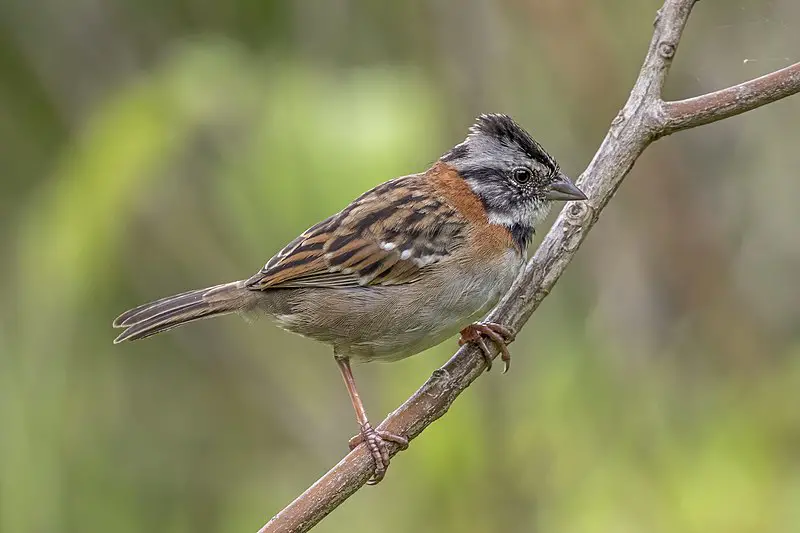
The Rufous-collared Sparrow, also known as the Andean sparrow, is a common bird found in open habitats from Mexico to Tierra del Fuego.
It has distinctive brown and white streaks on its back, with a reddish collar around its neck.
This species can be heard singing throughout much of the year and their vocalizations have been studied extensively since the 1970s.
They are omnivorous birds that feed mainly on seeds but will also consume insects for protein during breeding season.
The Rufous-collared sparrow often lives near humans and is an important part of many ecosystems across South America due to its role in helping disperse plant seeds including those used by people for food or livestock fodder production.Scientific classification:
| Kingdom | Animalia |
| Phylum | Chordata |
| Class | Aves |
| Order | Passeriformes |
| Family | Passerellidae |
| Genus | Zonotrichia |
| Species | Z. capensis |
Also Featured In: Uruguay birds,
43. Black-Browed Albatross
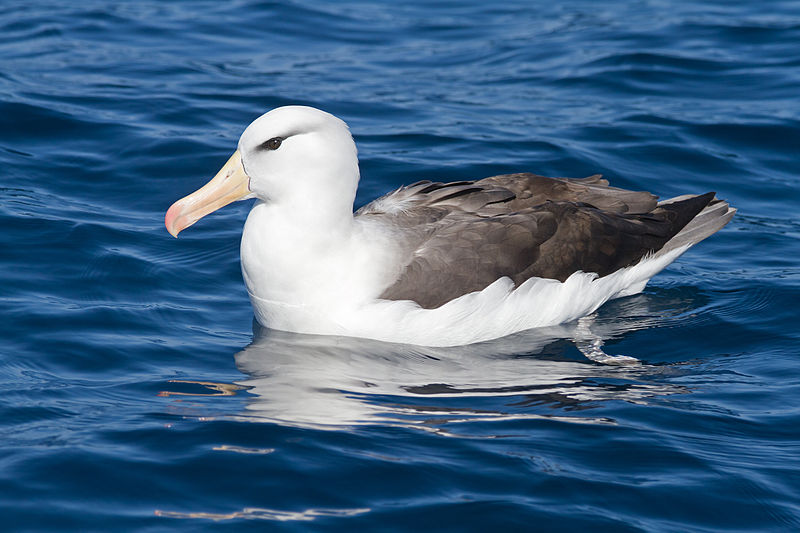
The Black-browed Albatross is a majestic seabird that belongs to the albatross family known as Diomedeidae.
It is an impressive bird, with its black beak and brow contrasting against white plumage on its wings and body.
The most widespread and common member of this group, it can often be seen flying around oceans in different parts of the world.
These birds share many features with other members of their order Procellariiformes, such as shearwaters, fulmars, storm petrels and diving petrels; they all have long wingspans for gliding effortlessly above water surfaces.
They feed mainly by scavenging or hunting small fish near sea surface while flying low over waters.
Its population has unfortunately declined due to commercial fishing vessels which attract them closer to shore resulting in entanglement into fishing nets leading them towards mortality.Scientific classification:
| Kingdom | Animalia |
| Phylum | Chordata |
| Class | Aves |
| Order | Procellariiformes |
| Family | Diomedeidae |
| Genus | Thalassarche |
| Species | T. melanophris |
Also Featured In: Antarctica Birds, Birds that Live around Victoria
44. King Penguin
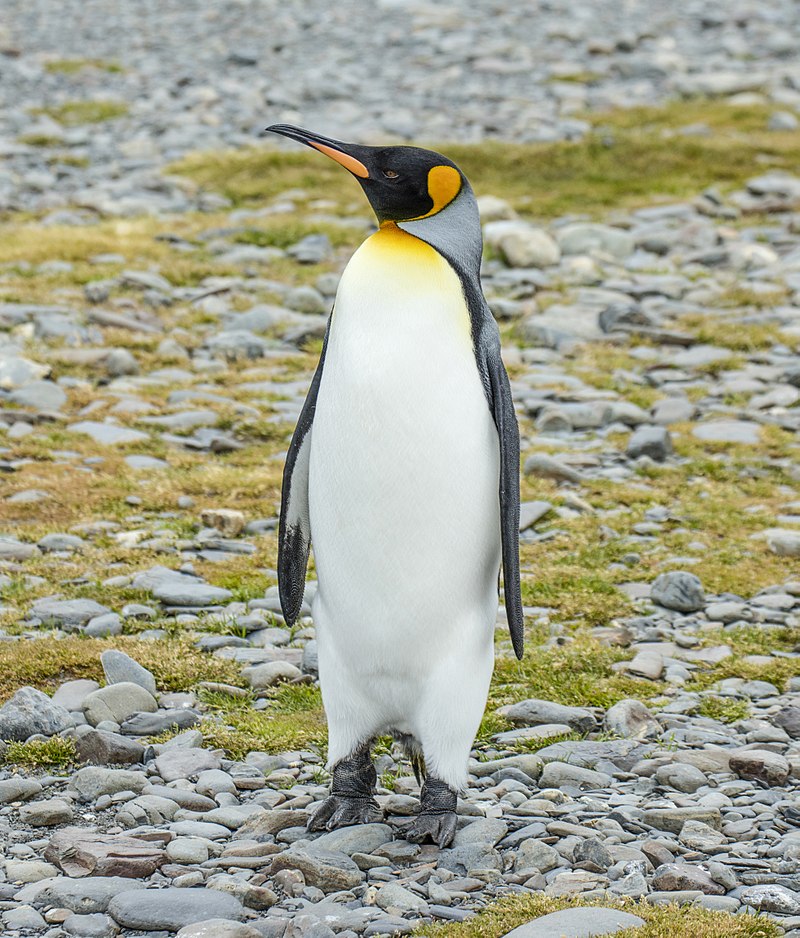
King penguins are majestic birds that live in the temperate and sub-Antarctic regions of the South Atlantic and Indian Oceans.
They stand up to 3 feet tall, making them smaller than their relative, the Emperor Penguin.
King Penguins have a distinctive two toned orange and black plumage with white markings on its face around its eyes which gives it an elegant look.
Unlike other species of penguin, they don’t migrate as much but stay close to breeding grounds year round living off from fish and squid found near shorelines or ice floes.
Their diet also consists of krill shrimp, small crustaceans such as copepods or amphipods eaten whole along with some occasional planktonic organisms like jellyfish for variety.
King Penguins form large colonies where males take part in incubation duties while females feed at sea for weeks at a time during mating season.Scientific classification:
| Kingdom | Animalia |
| Phylum | Chordata |
| Class | Aves |
| Order | Sphenisciformes |
| Family | Spheniscidae |
| Genus | Aptenodytes |
| Species | A. patagonicus |
Also Featured In: Native Birds Of West Falkland, Birds That Live around Saunders Island
45. Least Tern
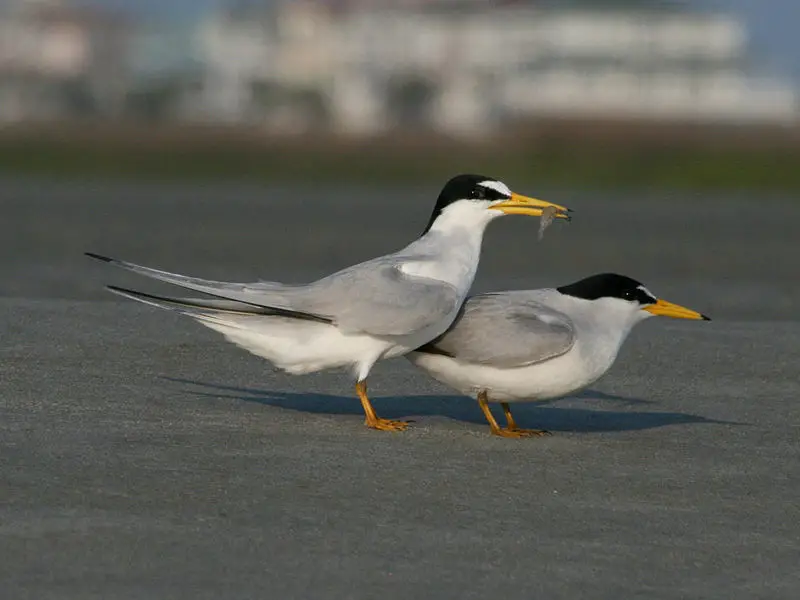
The Least Tern is a species of tern native to North America and northern South America. It has many close relatives, such as the yellow-billed tern and Peruvian tern from South America, or the little tern from the Old World.
The bird measures 8.7 – 9.4 inches in length with a wingspan of 16–18 inches acrosss, making it an intermediate size between most other species of birds within its family groupings.
Its feathers are usually gray on top with white underneath and typically have darker accents near their heads along with bright red bills for feeding during summer months when they mate upon beaches found throughout these regions mentioned above.
They feed mainly on small fish that live at shallow depths near shorelines where they also nest nearby due to migratory patterns which take place annually each year.
Hence why this particular bird does not travel far distances away from areas known as home for them over long periods of time like some other types do.Scientific classification:
| Kingdom | Animalia |
| Phylum | Chordata |
| Class | Aves |
| Order | Charadriiformes |
| Family | Laridae |
| Genus | Sternula |
| Species | S. antillarum |
Also Featured In: Aruba birds, Long Island Birds You Should Know
46. Guanay Cormorant
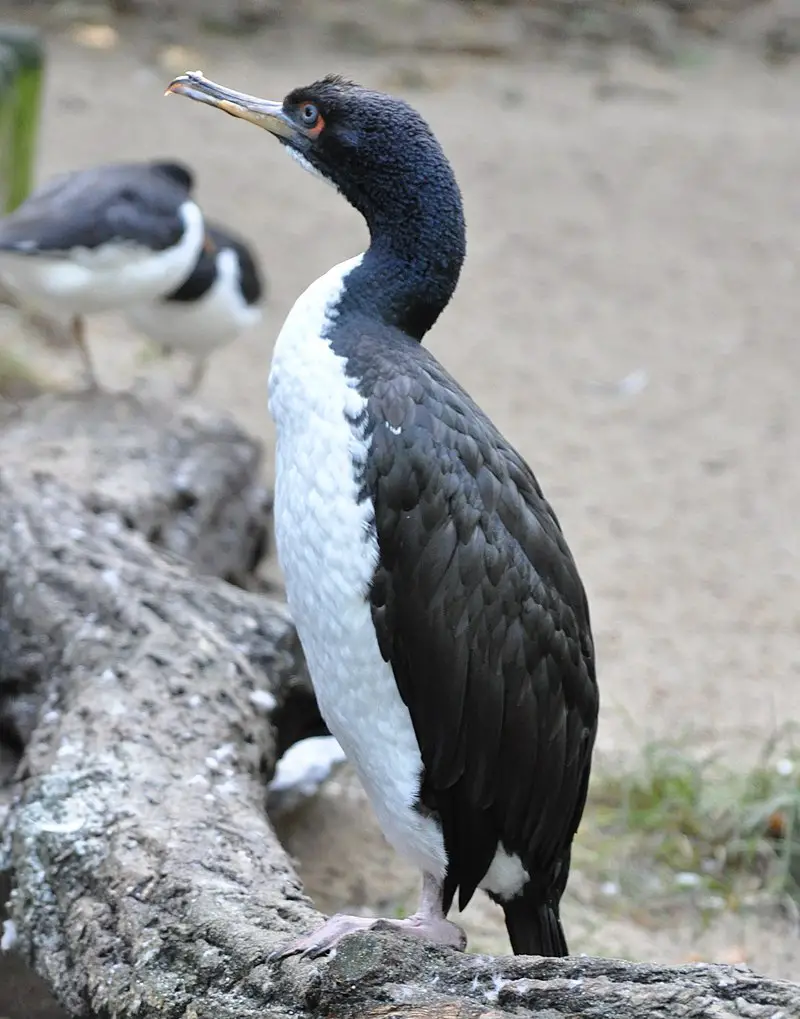
Guanay cormorant is a species of bird belonging to the cormorant family. It is found on the coasts of Peru and northern Chile, stretching southwards all the way to southern parts of Chile and north up to Ecuador.
There have even been records as far away as Panama and Colombia. They breed in large colonies near coastal areas which provide plenty of food for them such as fish, small crustaceans or other marine life.
Guanays are large birds with black feathers that become glossy blue-green when wet from swimming in their aquatic hunting grounds.
Their long neck allows them to dive deep below water searching for prey using its webbed feet like paddles.
A unique feature about these birds is that they use guano (their own droppings) build nests made out of mud, seaweed or sticks high above cliffs so predators can’t reach them easily.Scientific classification:
| Kingdom | Animalia |
| Phylum | Chordata |
| Class | Aves |
| Order | Suliformes |
| Family | Phalacrocoracidae |
| Genus | Leucocarbo |
| Species | L. bougainvilliorum |
Also Featured In: Cormorant Species,
47. Buff-Breasted Sandpiper
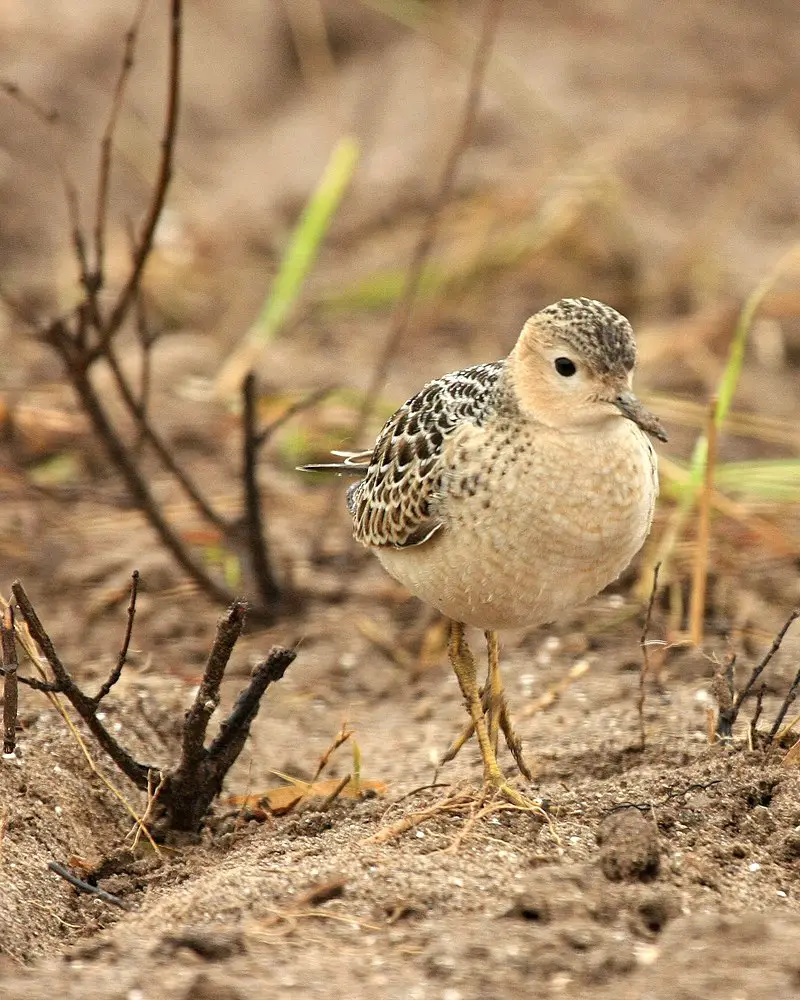
The Buff-breasted sandpiper is a tiny shorebird with a brown upper body and a buff-colored face and underparts. Its Latin name, Calidris subruficollis, means “reddish-necked” due to its somewhat rufous neck.
The bird boasts a short bill and striking yellow legs. Both males and females possess the same plumage.
It is considered a calidrid sandpiper and is a migratory bird that travels across the Americas from the Arctic tundra to South America during the breeding season.
This bird is found in open habitats, such as prairies, wet meadows, and shores. The Buff-breasted sandpiper is currently facing threats due to loss of habitat, hunting, and human disturbance.
Conservation efforts are being put in place to save this bird from extinction.Scientific classification:
| Kingdom | Animalia |
| Phylum | Chordata |
| Class | Aves |
| Order | Charadriiformes |
| Family | Scolopacidae |
| Genus | Calidris |
| Species | C. subruficollis |
Also Featured In: Common Birds in London, Common Northwest Territories Birds
48. Jocotoco Antpitta
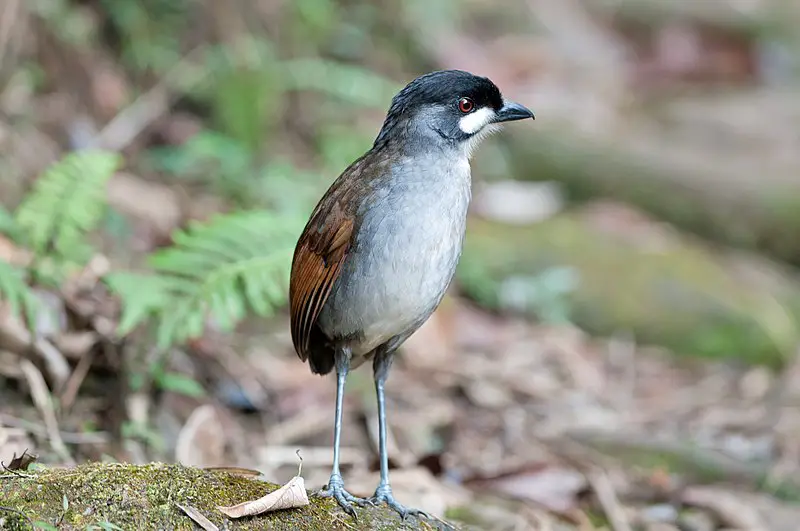
The Jocotoco antpitta, a bird native to Ecuador and Peru, is listed as an endangered species. It was discovered in 1997 and scientifically described in 1999.
This large bird, weighing between 150-200g, features a unique head pattern with tufts of white plumes below its eyes. Its song is similar to the hooting of the rufous-banded owl.
The Jocotoco antpitta’s closest relatives are believed to be other antpitta species. Due to its rarity and threatened status, conservation efforts are in place to protect this unique bird species.Scientific classification:
| Kingdom | Animalia |
| Phylum | Chordata |
| Class | Aves |
| Order | Passeriformes |
| Family | Grallariidae |
| Genus | Grallaria |
| Species | G. ridgelyi |
49. Plumbeous Kite
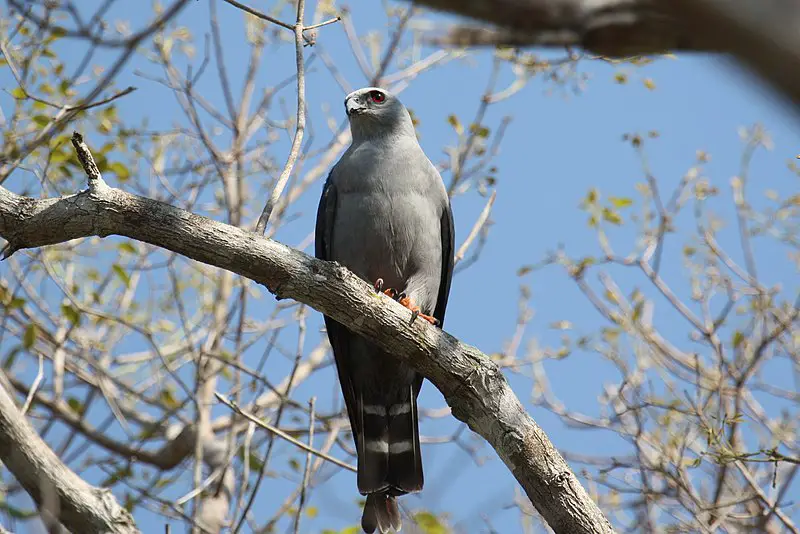
The Plumbeous Kite bird is a member of the Accipitridae family and is a resident in the northern region of South America. These birds are migratory in the northern area of their range, extending to Mexico.
They feed on insects and catch them while sitting on a perch or while flying. The Plumbeous Kite was first described by Johann Friedrich Gmelin in 1788.Scientific classification:
| Kingdom | Animalia |
| Phylum | Chordata |
| Class | Aves |
| Order | Accipitriformes |
| Family | Accipitridae |
| Genus | Ictinia |
| Species | I. plumbea |
50. Great Black Hawk
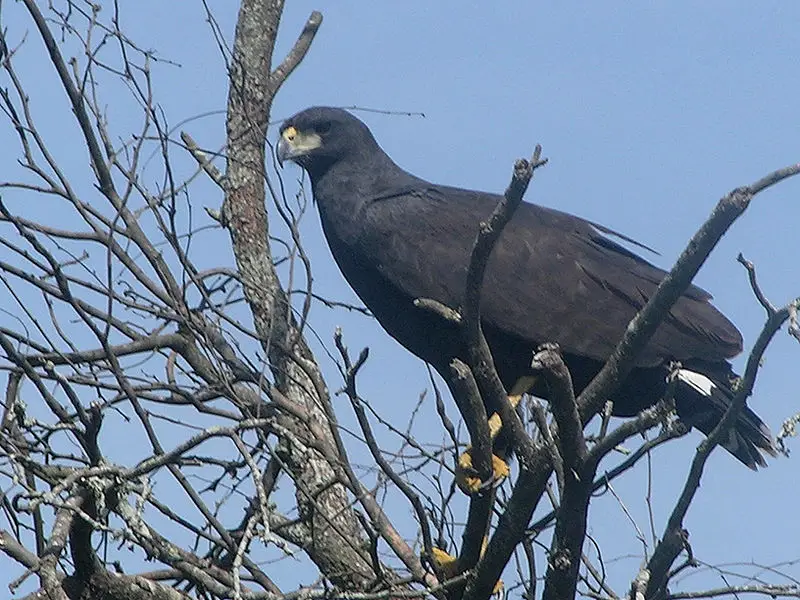
The Great Black Hawk, a bird of prey belonging to the Accipitridae family, is often associated with eagles, hawks, and Old World vultures. It was first described in 1788 by Johann Friedrich Gmelin, a German naturalist.
Unlike some other birds of prey, the Great Black Hawk has dark feathers all over its body. It is a powerful hunter and feeds on a variety of small animals, including rodents, reptiles, and other birds.
This bird is found in Central and South America and is generally known for its striking appearance and strong hunting skills.
Despite this bird’s beauty and importance to the ecosystem, it has faced threats from habitat destruction and illegal hunting. As a result, conservationists are working to protect the Great Black Hawk and its habitat from these dangers.Scientific classification:
| Kingdom | Animalia |
| Phylum | Chordata |
| Class | Aves |
| Order | Accipitriformes |
| Family | Accipitridae |
| Genus | Buteogallus |
| Species | B. urubitinga |
51. Antbird
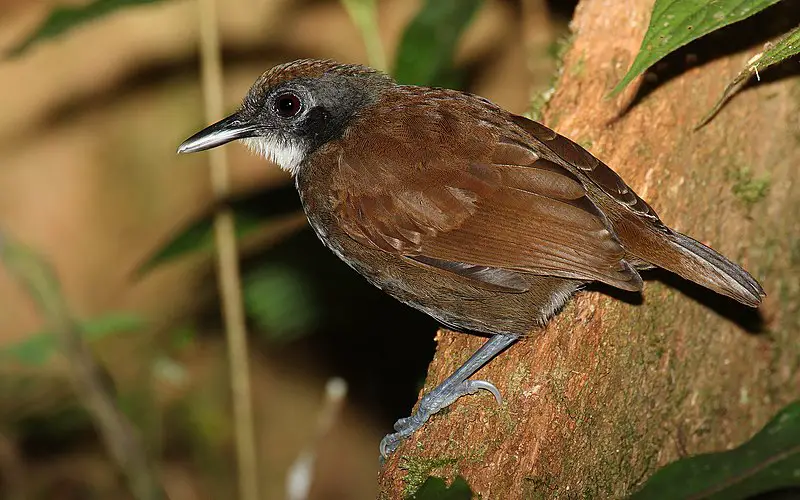
Antbirds are passerine birds found in Central and South America. They belong to the Thamnophilidae family, which includes over 230 species known by different names such as antshrikes, antwrens, antvireos, fire-eyes, bare-eyes, and bushbirds.
They are closely related to antthrushes, antpittas, tapaculos, gnateaters, and ovenbirds. These birds have varied appearances and live in subtropical and tropical regions.
They feed on insects, spiders, and other invertebrates, and some species participate in mixed-species flocks for added protection from predators.
The antbird’s habitat includes humid forests, savannas, and shrublands. These birds play a crucial role in maintaining ecosystem balance and are crucial to the food chain.Scientific classification:
| Kingdom | Animalia |
| Phylum | Chordata |
| Class | Aves |
| Order | Passeriformes |
| Parvorder | Furnariida |
| Family | Thamnophilidae Swainson, 1824 |
Also Featured In: Birds that Live in Guyana,